In the world of plants, white flowers not only possess a pure beauty but also symbolize many profound meanings. This article will introduce you to 81 popular types of white flowers, helping you explore the diversity of types of white flowers from around the globe.
From tiny blooms to large and magnificent species, each flower has its own story and unique charm. Let’s delve into these types of white flowers through stunning images and their names.
Different Types of White Flowers
Peony Flowers
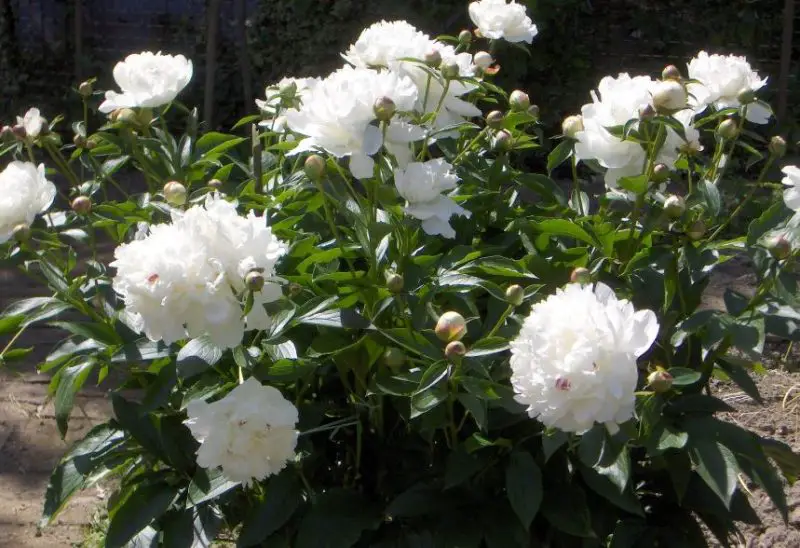
Peony flowers (Paeonia), the only genus in the Paeoniaceae family, include about 33 officially accepted species native to western North America, Europe, and Asia. Mostly herbaceous perennials, with some species growing as shrubs, peonies are known for their lush foliage and stunning blossoms.
These flowers bloom in a variety of forms, including single, semi-double, and double varieties. Peonies, especially in brilliant white, add elegance and beauty to gardens, particularly when illuminated by sunlight on a bright day.
Bouvardia
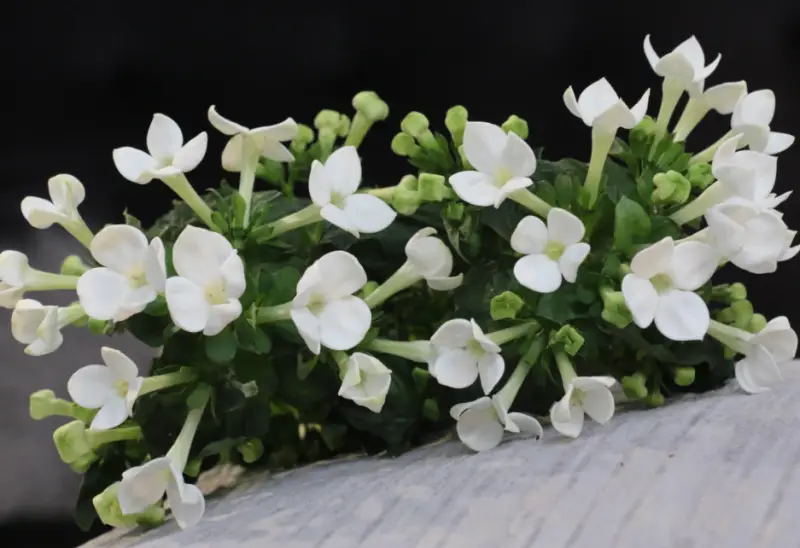
Bouvardia (Bouvardia) is a genus of about 50 species of evergreen shrubs and herbs in the Rubiaceae family, mostly native to Mexico and Central America, with one species found in the southwestern United States.
These plants produce delicate clusters of four-lobed flowers in shades of yellow, pink, red, and white. Bouvardia flowers are popular as houseplants or outdoor garden plants in warmer climates, admired for their small, elegant blooms and lush green foliage.
Star of Bethlehem
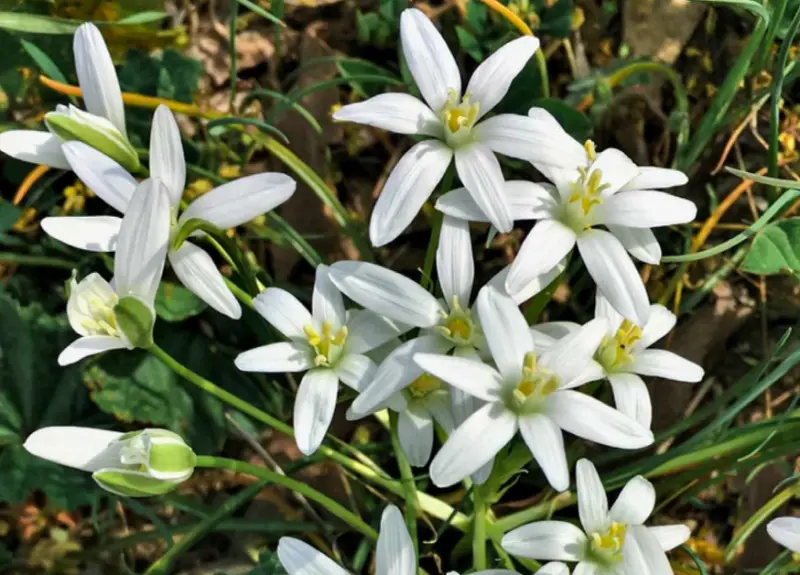
Star of Bethlehem (Ornithogalum) is a genus of bulbous, perennial plants in the Asparagaceae family, native to southern Africa, southern Europe, and the Caucasus. Known for their bright white, six-petaled, star-shaped flowers with yellow centers, these plants grow from grassy clumps of foliage.
The striking blooms give the plant its common name, “Star of Bethlehem,” and are often used to add a touch of elegance to gardens and floral arrangements.
Steptocarpus
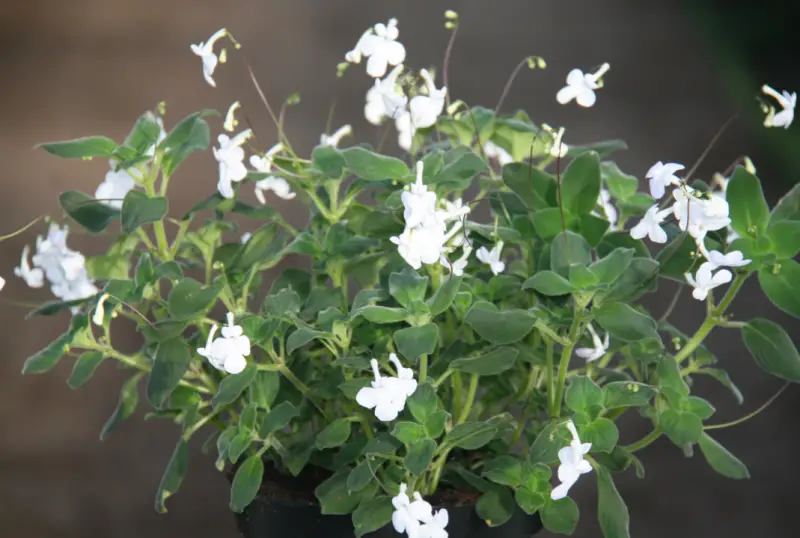
Streptocarpus (Streptocarpus) is a genus of plants in the Gesneriaceae family, native to the Afrotropical region. The name derives from Greek, meaning “twisted fruit,” referring to the plant’s long, tusk-like fruits.
Streptocarpus plants form central rosettes of large, glossy leaves, from which slender stalks emerge. Atop these stalks, delicate, slightly tubular flowers resembling orchids bloom, often in shades of white with lime green centers, adding an exotic touch to any garden or indoor display.
Daffodil
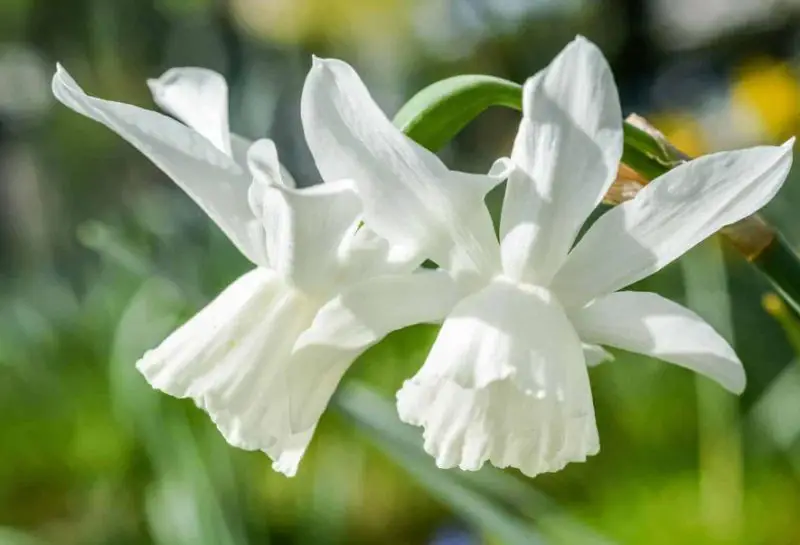
Daffodil (Narcissus) is a genus of about 50 species of flowering perennials in the Amaryllidaceae family, native to southern Europe and northern Africa. Commonly known as narcissus, jonquil, or daffodil, these plants are a symbol of spring, often blooming early in the season or even in late winter.
Daffodils produce star-shaped blossoms with distinctive trumpet-like centers, typically in bright yellow or white, adding a cheerful touch to gardens and landscapes.
Osmanthus
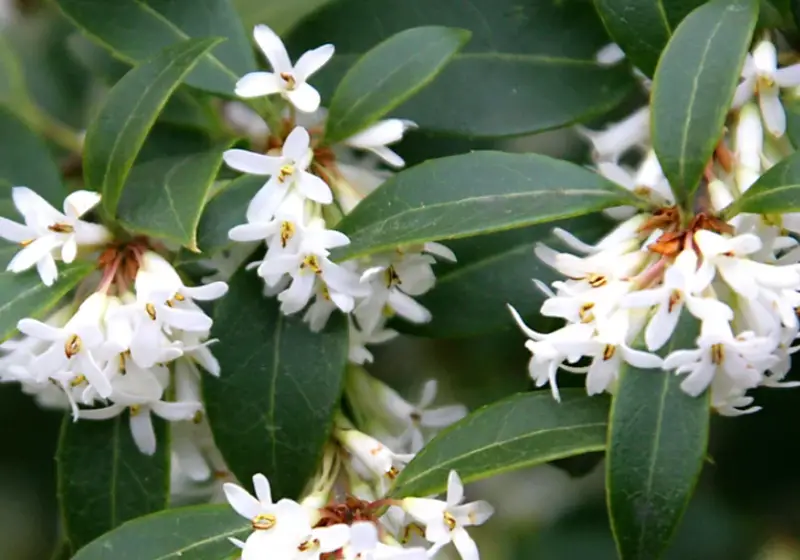
Osmanthus (Osmanthus) is a genus of about 30 species in the Oleaceae family, consisting of woody shrubs and small trees. Known for their attractive sage-colored, ovate foliage, these plants produce delicate sprays of petite white flowers that bloom along the stems, resembling clusters of snow.
Native primarily to eastern Asia, some species also grow in Sumatra, New Caledonia, and the Caucasus. Osmanthus is cherished for its ornamental beauty and fragrant blossoms, making it a popular choice in gardens.
Peruvian Lily
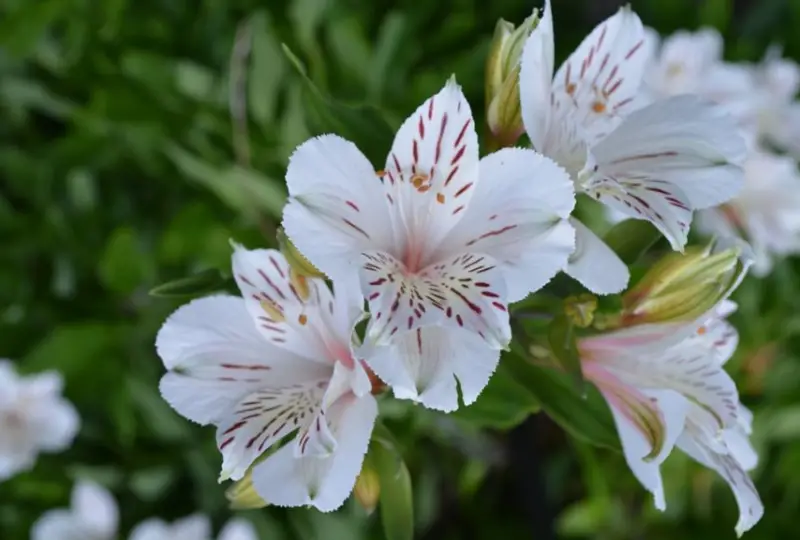
Peruvian Lily (Alstroemeria) is a genus of about 50 species, plus hundreds of cultivars and hybrids, belonging to the Alstroemeriaceae family. Native to South America, these long-living perennials are also known as the lily of the Incas.
Peruvian lilies bloom atop tall stalks, producing vibrant flowers in shades of white, pink, red, orange, purple, and green. The blossoms are adorned with speckles, stripes, and dots in darker hues, adding intricate beauty to indoor displays and gardens alike.
Mock Orange
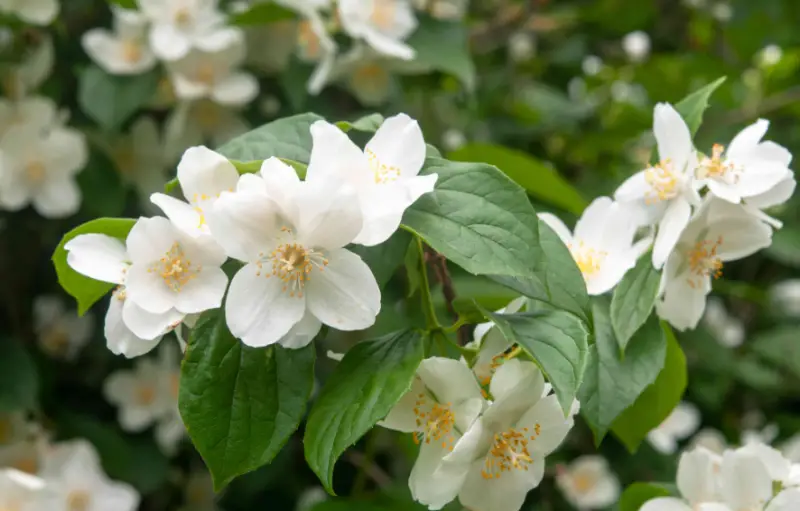
Mock Orange (Philadelphus) is a genus of about 60 species of mostly deciduous, flowering shrubs in the Hydrangeaceae family, native to southeastern Europe, Asia, North America, and Central America. Named for their resemblance to orange blossoms, mock orange flowers feature delicate white petals with bright yellow stamens.
These blooms are known for their sweet, citrusy fragrance, reminiscent of orange and lemon blossoms, with a subtle jasmine undertone, making them a favorite in gardens and landscapes for both beauty and scent.
Trumpet Flower
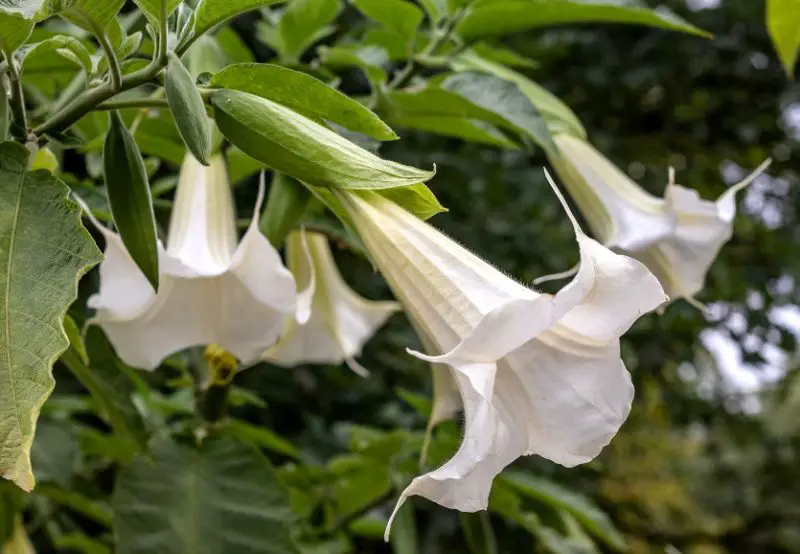
Trumpet Flower (Brugmansia), commonly known as angel’s trumpets, comprises seven species of flowering plants in the Solanaceae family, native to the tropical regions of South America. These plants can grow as woody shrubs or trees and are renowned for their strikingly large, trumpet-shaped flowers that can measure between 6 and 20 inches long.
The flowers hang gracefully from the plant’s lush foliage, resembling Christmas tree ornaments. While beautiful, it’s important to note that these flowers are highly toxic, adding a cautionary element to their allure in gardens.
Lisianthus Flowers
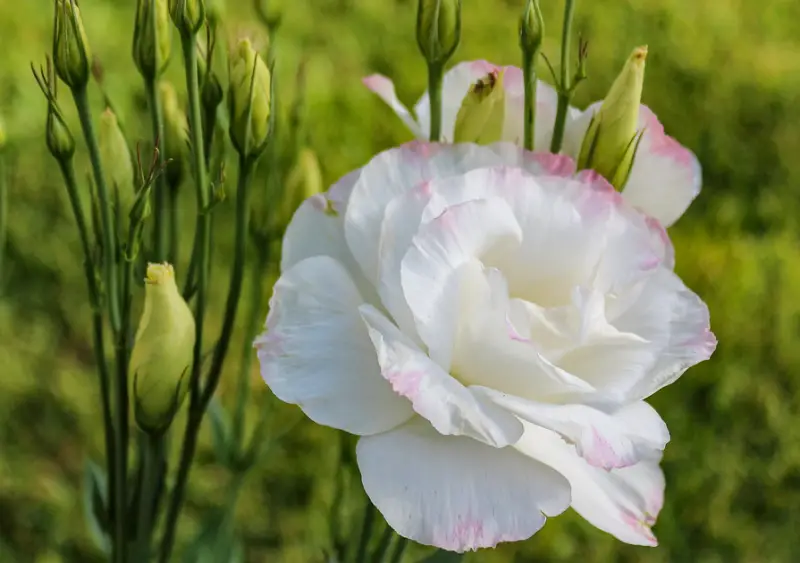
Lisianthus Flowers (Eustoma) are a genus consisting of three species of herbaceous annual flowering plants in the Gentianaceae family, native to South America, the Caribbean, Mexico, and the southern United States. Commonly known as prairie gentian, lisianthus flowers feature long, slender stalks topped with stunning, whorl-shaped blossoms that resemble roses.
These elegant flowers are cherished for their delicate beauty and are often used in floral arrangements, adding a touch of sophistication to any setting.
Woodland Tobacco
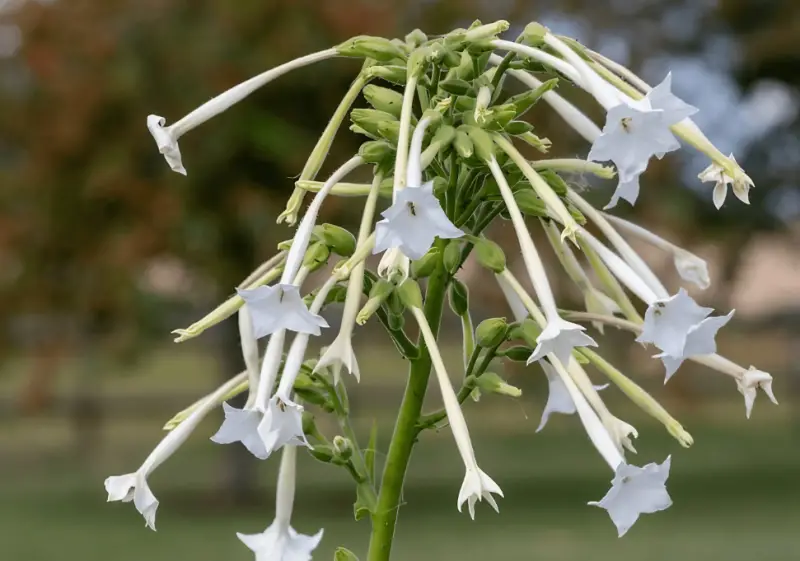
Woodland Tobacco (Nicotiana sylvestris) is a flowering plant in the Solanaceae family, commonly referred to as South American tobacco or flowering tobacco. These plants can be biennial or short-lived perennials, reaching heights of nearly 5 feet.
Known for their distinctive pendulous, tube-shaped flowers, woodland tobacco produces blossoms that unfurl into broad, star-like shapes at their ends. Their elegant white flowers and tall stature make them a striking addition to gardens, attracting pollinators and adding visual interest to landscapes.
Cosmos Flowers
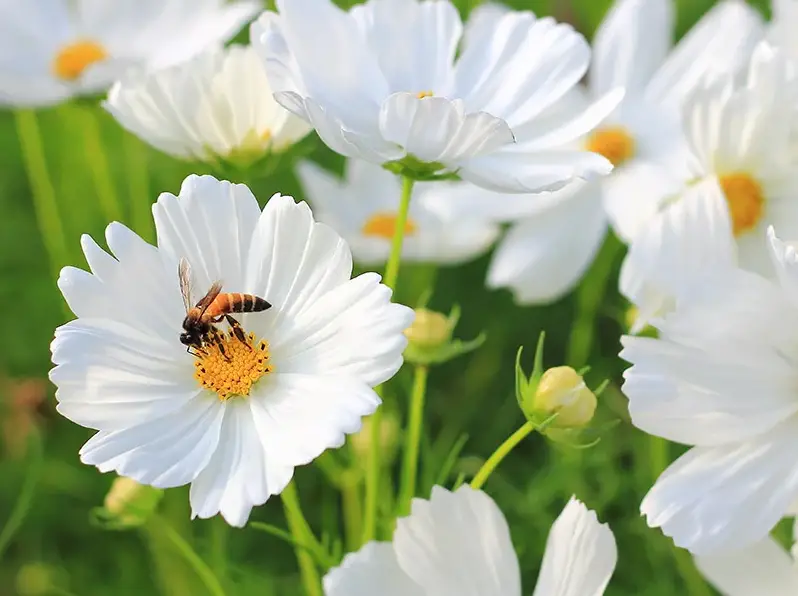
Cosmos Flowers (Cosmos) belong to a genus of 36 species of herbaceous perennial plants in the Asteraceae family. Most species are native to Mexico, with some found in the northwestern United States, Central America, and South America.
Characterized by their spindly, grass-like stems and delicate leaves, cosmos plants have a whimsical look as they sway in the breeze. They produce cheerful flowers featuring striking ray florets surrounding a central disc floret, with the species Cosmos bipinnatus naturally blooming in pure white, adding a bright touch to gardens.
Moth Orchid
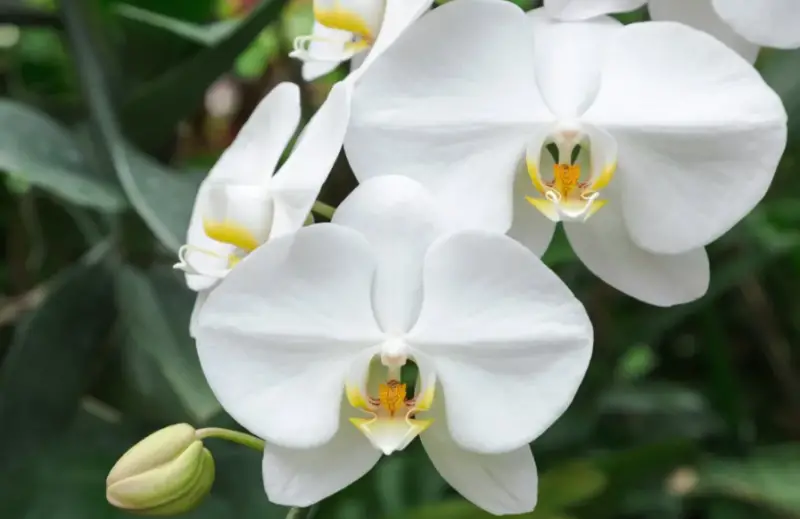
Moth Orchid (Phalaenopsis) is a genus comprising about 70 species of epiphytic plants in the Orchidaceae family. These orchids feature large, waxy leaves that grow in a deep green shade at the base. From the center of this foliage, long, woody stems emerge, producing several long-lasting, fragrant flowers.
Commonly known as moth orchids, they are primarily native to the Philippines and Indonesia, though some species can be found in southern China, India, Malaysia, New Guinea, and Queensland, Australia. Their elegant blooms and distinctive appearance make them popular in floral arrangements and as houseplants.
Meadowsweets
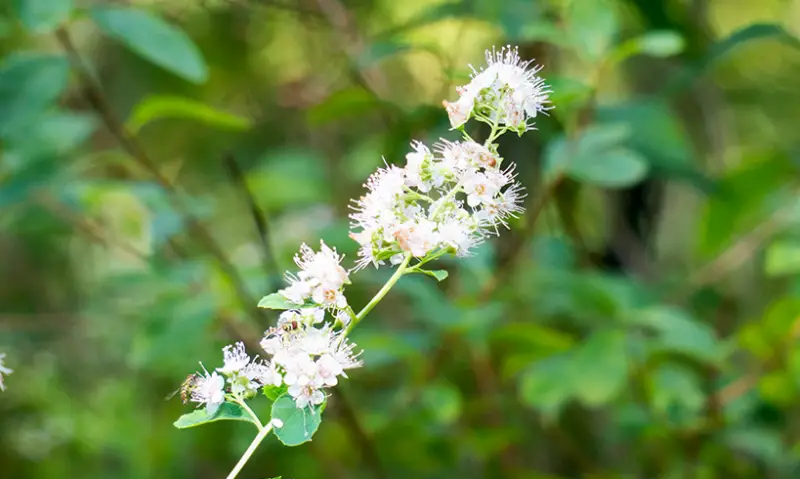
Meadowsweets (Spiraea) are a genus of 80 to 100 species of woody flowering shrubs in the Rosaceae family, commonly known as steeplebushes or meadowsweets. These shrubs are visually striking, especially when in bloom, as they produce large panicles, corymbs, or drooping clusters of flowers that nearly envelop the entire plant in blossoms.
The flowers appear small and fuzzy, with numerous stamens protruding from the blossoms, adding to their charm. In addition to their stunning floral displays, meadowsweets also feature attractive foliage, making them a delightful addition to gardens and landscapes.
Common Daisy
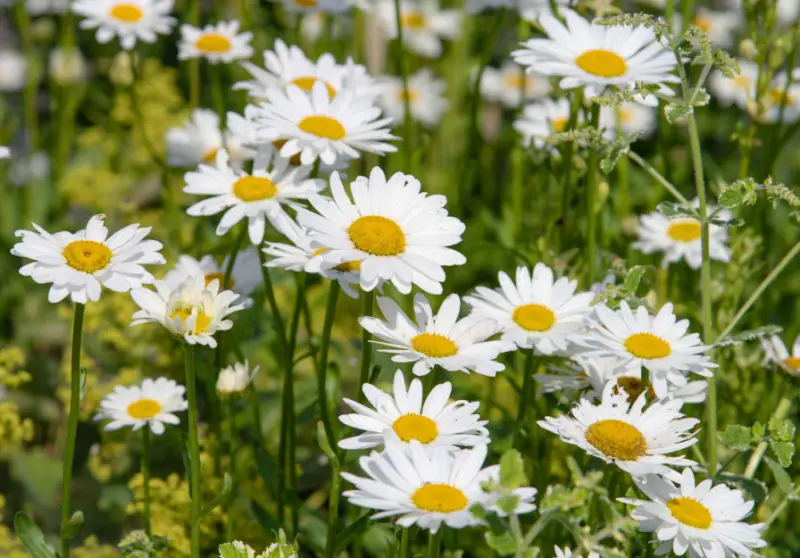
The Common Daisy (Bellis perennis) is a perennial herbaceous plant native to Europe, belonging to the Asteraceae family. It is easily recognized by its classic appearance: a ring of white petals surrounding a bright yellow center.
Also known as the English daisy or lawn daisy, this plant is often found in meadows and gardens. While typically white, some varieties bloom in shades of pink, red, and yellow, adding a splash of color to their natural habitat.
Bellflowers
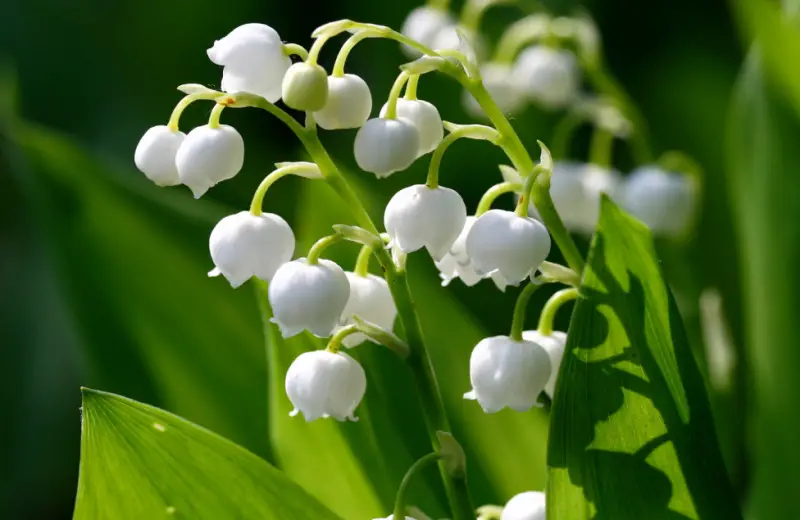
White bellflowers (Campanula) are part of a large genus with over 500 species and numerous subspecies within the Campanulaceae family. Known for their bell-shaped blooms, they get their name from the Latin word for “little bell.”
While most species are native to the Middle East and Caucasus, many thrive in temperate and subtropical regions across the Northern Hemisphere. These versatile plants can be annuals, biennials, or perennials, blooming in shades of white, blue, purple, and pink.
Moonflower
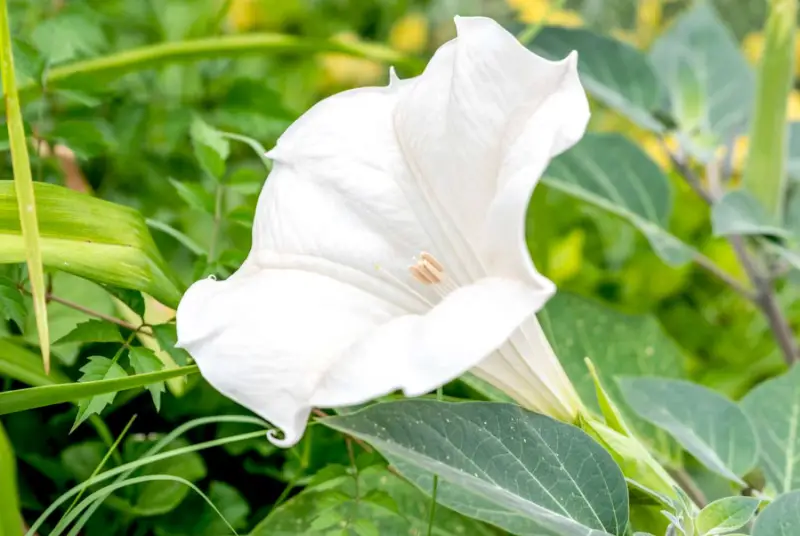
Moonflower (Ipomoea alba) is a night-blooming vine in the Ipomoea genus, which includes over 600 species in the Convolvulaceae family. Also known as moonvine or tropical morning glory, this plant is native to tropical and subtropical regions of the Americas.
It can grow up to 100 feet tall and produces large, trumpet-shaped white or light pink flowers. These blooms, nearly 6 inches wide, release a sweet fragrance, especially when they open at night, making them popular in night gardens.
Hyacinth Flowers
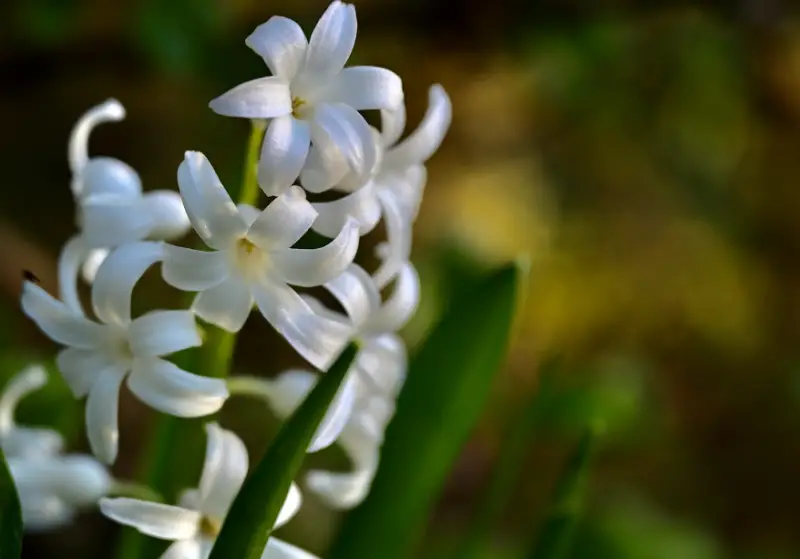
Hyacinth flowers (Hyacinthus) are bulbous perennials from the Asparagaceae family, native to the eastern Mediterranean. Known for their early spring bloom, they often emerge through snow, brightening gardens with their fragrant flowers.
The most common species is Hyacinthus orientalis, widely grown for its colorful, aromatic blooms. Each plant produces one to three spikes of flowers in shades like white, blue, purple, red, pink, peach, and yellow, making them a popular choice for both gardens and floral arrangements.
Magnolia
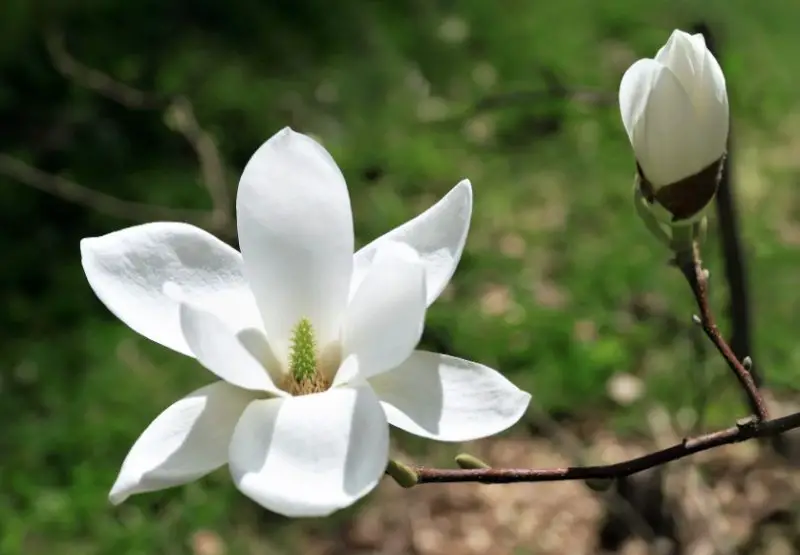
Magnolia (Magnolia) is a genus of flowering plants from the Magnoliaceae family, with hundreds of species. Evolving before bees, magnolias rely on beetles for pollination. Unlike typical flowers, magnolias don’t have true petals but instead feature milky-white tepals.
The genus has two main centers of origin: one in the Americas and the other in East and Southeast Asia, where magnolias thrive as striking ornamental plants with large, fragrant blooms.
Larkspur
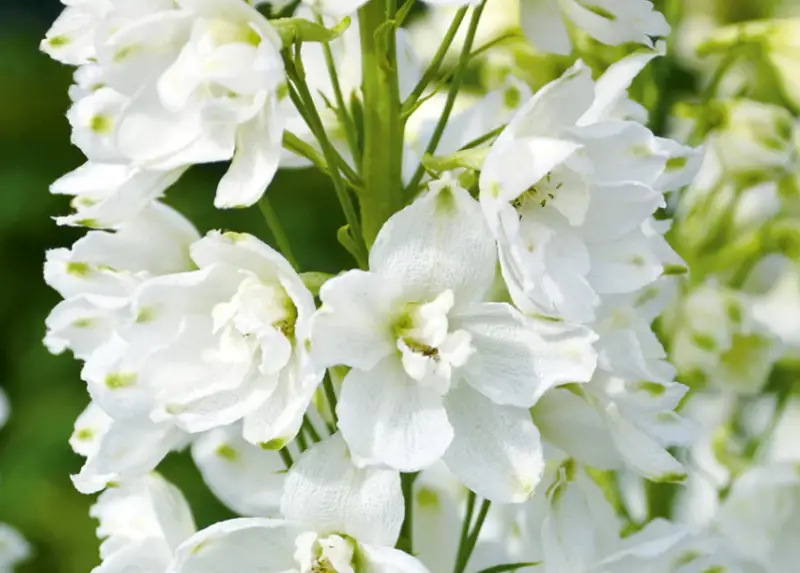
Larkspur (Delphinium) is a genus of around 300 species belonging to the Ranunculaceae family, native to the Northern Hemisphere and some tropical African mountains. These plants, known for their tall spikes of blossoms, come in both annual and perennial varieties.
When in bloom, larkspurs display flowers in shades of purple, blue, pink, and white. The genus name, derived from the Greek word “delphínion” meaning dolphin, references the flower’s dolphin-like shape.
Baby’s Breath
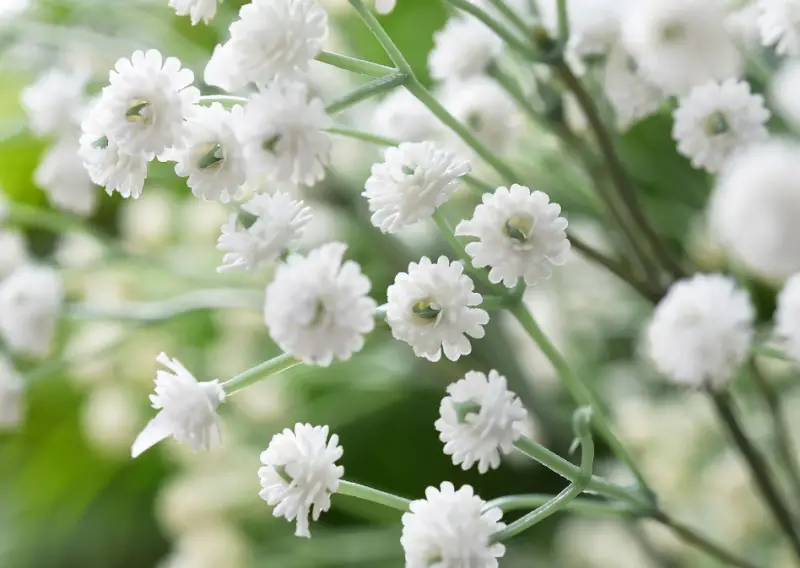
Baby’s Breath (Gypsophila) is a genus of around 150 species in the Caryophyllaceae family, known for its delicate sprays of tiny white flowers. Native to regions across Europe, Asia, Northern Africa, Australia, and the Pacific Islands, this plant is popular in both fresh and dried floral arrangements.
Despite its charm, baby’s breath is considered invasive in many areas due to its rapid growth. The flowers add an airy, elegant touch to bouquets and landscapes alike.
Chrysanthemum Flowers
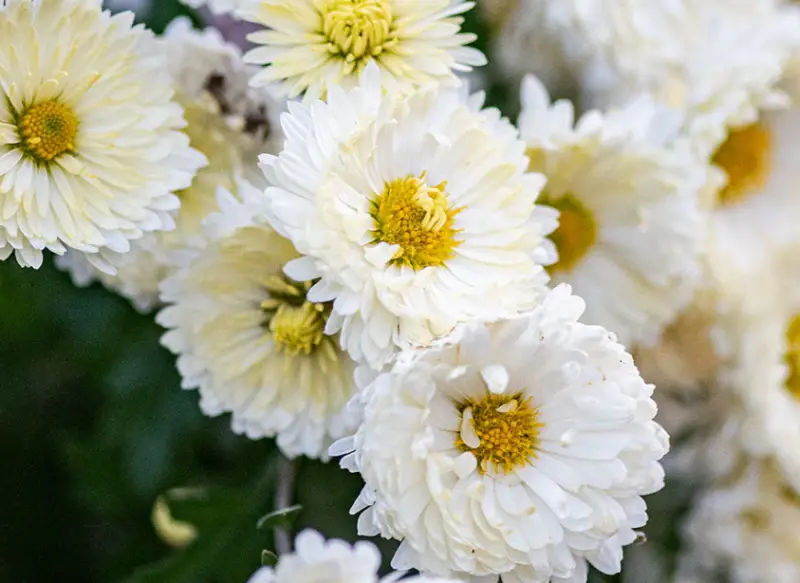
Chrysanthemum flowers (Chrysanthemum) are a genus of about 40 species in the Asteraceae family, consisting of subshrubs and herbaceous perennials. Native to northeastern Europe and eastern Asia, particularly China, chrysanthemums are known for their vibrant blooms in nearly every color, including white.
White varieties come in various flower forms, such as reflexed, incurved, pompon, single, and quill. These iconic flowers are cherished for their fullness and bright presence, often blooming against the backdrop of a clear blue sky.
Foxgloves
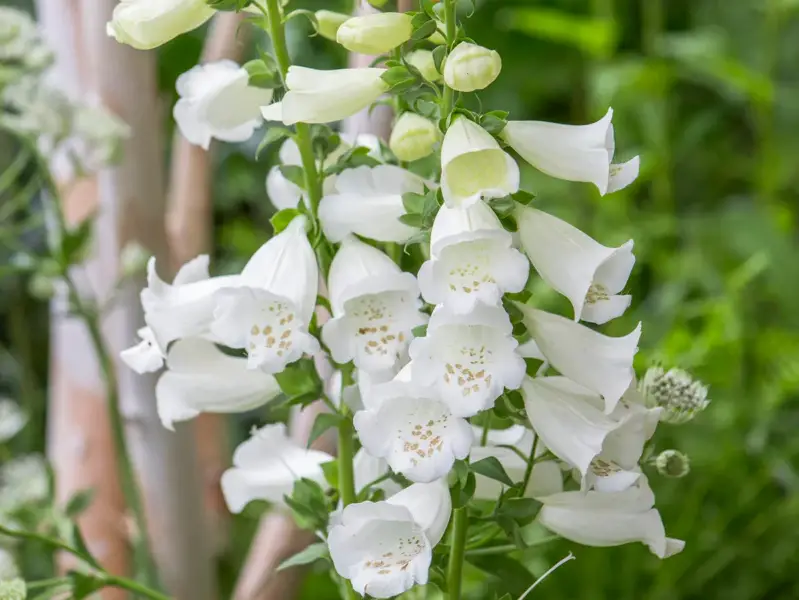
Foxgloves (Digitalis) are a genus of about 20 species in the Plantaginaceae family, consisting of perennial and biennial plants and shrubs. Native to northwestern Africa, Europe, and western Asia, foxgloves are known for their tall spikes adorned with tubular flowers in shades of purple, pink, and white.
These striking blooms, often with speckled centers, create ornamental racemes that attract butterflies and moths, making them popular in gardens for both their beauty and wildlife appeal.
Petunia Flowers

Petunia flowers (Petunia) belong to a genus of 20 species in the Solanaceae family, native to South America. These perennial plants are popular in gardens, often grown in containers, hanging baskets, and window boxes due to their clumping or trailing growth habits.
Petunias produce trumpet-shaped, star-like flowers in shades of white and many vibrant color combinations. They blossom in a wide variety of patterns, with petals that can be solid, striped, or speckled, adding beauty to any garden.
Hydrangea Flowers
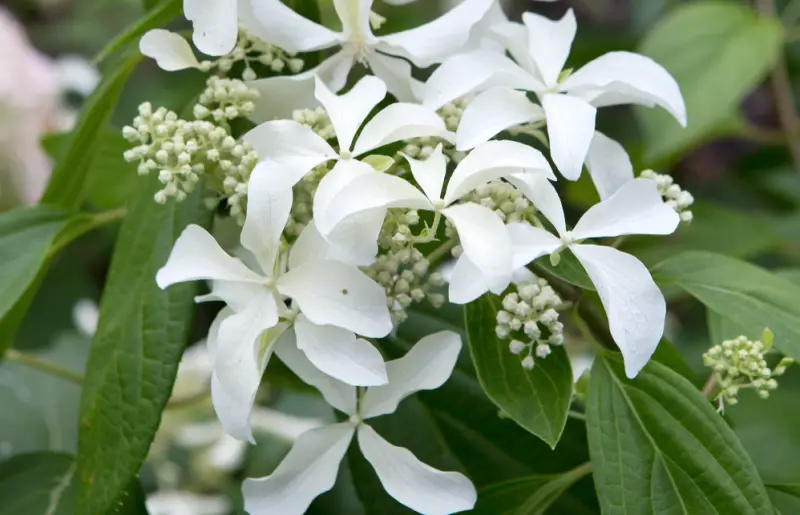
Hydrangea flowers (Hydrangea), commonly known as hydrangea or hortensia, belong to a genus of about 75 species in the Hydrangeaceae family. Native to the Americas and Asia, with most originating in Japan, China, and Korea, hydrangeas can grow as woody vines or small trees. Popular garden varieties are typically deciduous and produce large, globe-shaped clusters of flowers.
While naturally greenish-white, hydrangea blooms can also appear in shades of pink, blue, or purple depending on soil pH, adding vibrant beauty to any landscape.
Dahlia Flowers
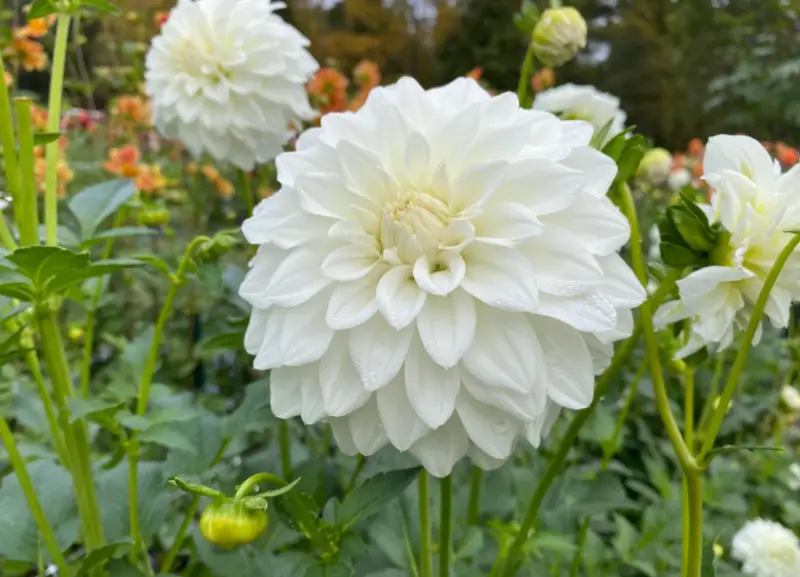
Dahlia flowers (Dahlia), part of the Asteraceae family, include 42 species of herbaceous perennials native to Central America and Mexico. Known for their striking, layered flower heads, dahlias display numerous pointed petals arranged in captivating geometric patterns.
These showy blooms come in a wide range of colors, including creamy white, and are cherished in gardens for their vibrant beauty and variety. Their eye-catching appearance adds elegance to any setting, including against an azure-colored backdrop.
Calla Lily
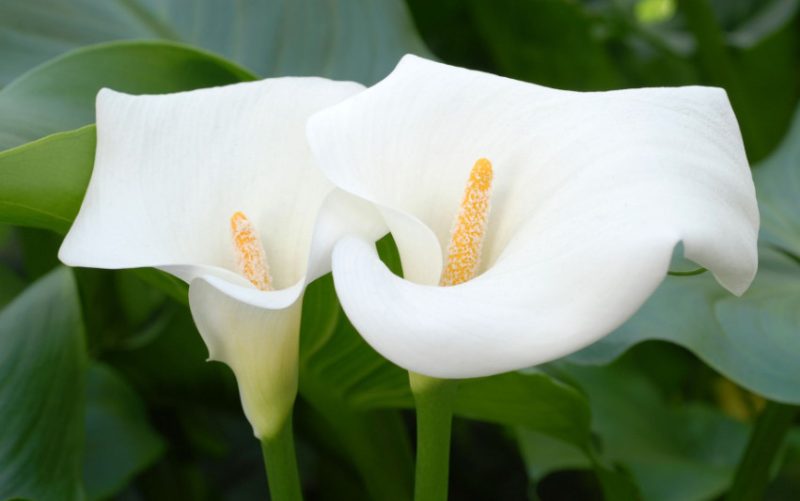
The Calla Lily (Zantedeschia) is a herbaceous perennial plant native to southern Africa, belonging to the Araceae family. Though commonly called calla or arum lilies, they are neither true lilies nor callas. The plant features a showy spathe resembling a curved, funnel-shaped petal, and a central, yellow, finger-like spadix.
These elegant flowers grow atop sturdy green stalks. Among the eight species, five bloom in white, pinkish-white, yellowish-white, or cream shades, making them popular in gardens and floral arrangements.
Hibiscus Flowers
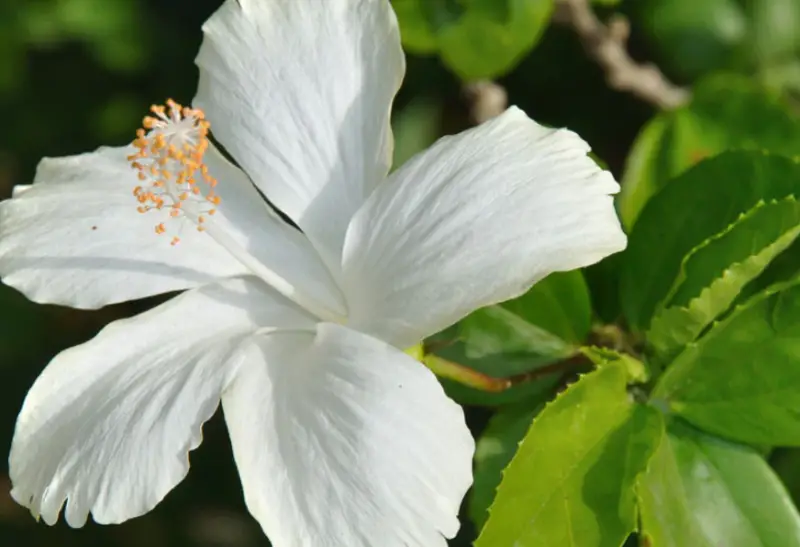
The Hibiscus (Hibiscus) is a large genus of flowering plants in the Malvaceae family, found in tropical, subtropical, and temperate regions worldwide. Known for their large, showy blooms, hibiscus flowers often appear in vibrant hues like red, orange, and pink, but they also bloom in pastels and white.
A single white hibiscus flower stands out with its delicate, trumpet-shaped petals. Some have pure-white stigmata, while others display striking red, pink, or yellow stigmata emerging from their centers.
Amaryllis Flowers
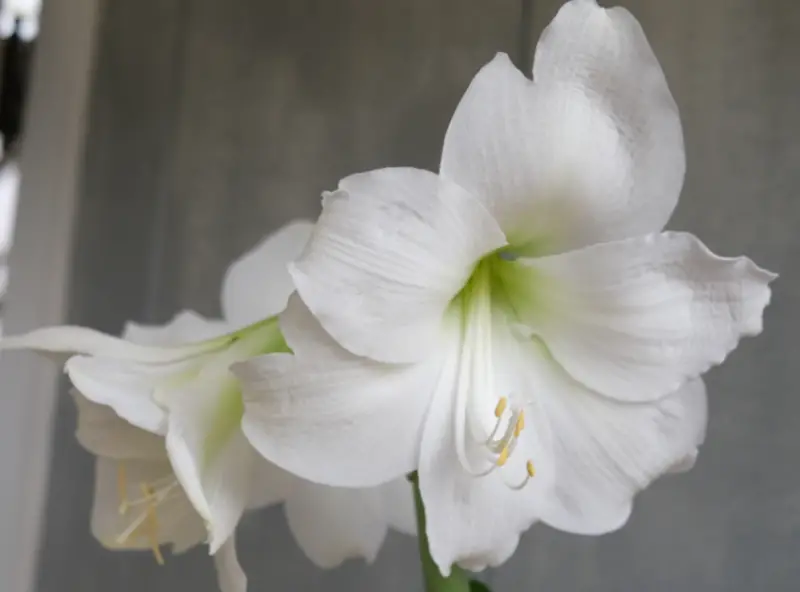
Amaryllis (Amaryllis) is a genus native to South Africa, containing two species of bulbous, flowering plants in the Amaryllidaceae family. Known for their large, striking blooms that resemble stargazer lilies, they are popular for holiday gifting, especially during the winter.
Amaryllis flowers come in various colors, with white and vibrant red varieties being particularly popular. Their showy, trumpet-shaped blossoms add elegance and a festive touch to indoor spaces during the colder months.
Gerbera Daisy Flowers

Gerbera Daisy (Gerbera) is a genus of herbaceous perennial plants native to the tropical regions of Africa, belonging to the Asteraceae family. Known for their daisy-shaped blooms, Gerbera daisies feature thick, ruffled petals and prominent circular centers, supported by sturdy, slightly fuzzy stems.
These vibrant flowers come in a range of colors, from bright oranges and reds to soft pinks and whites. The white variety, with its delicate, feathery petals, adds a touch of elegance to any floral arrangement.
Nemesia
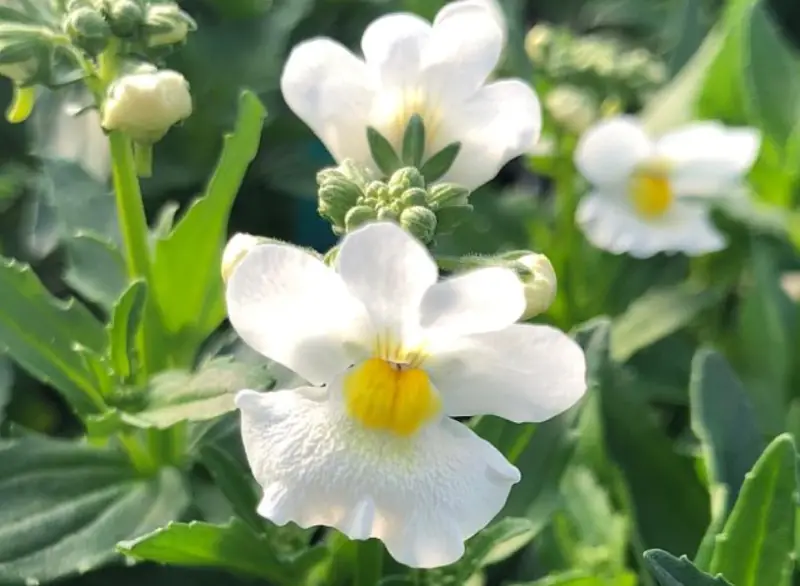
Nemesia (Nemesia) is a genus in the Scrophulariaceae family, comprising 64 species of perennial and annual flowering sub-shrubs native to South Africa. These plants are known for their distinctive two-lipped flowers, with the top lip having four lobes and the bottom lip featuring two.
Nemesia typically grows to about a foot in height and is popular for edging borders, ground cover, and containers. In addition to the white variety, their blooms come in vibrant shades of yellow, lavender, violet, pink, and orange.
Winter Heath
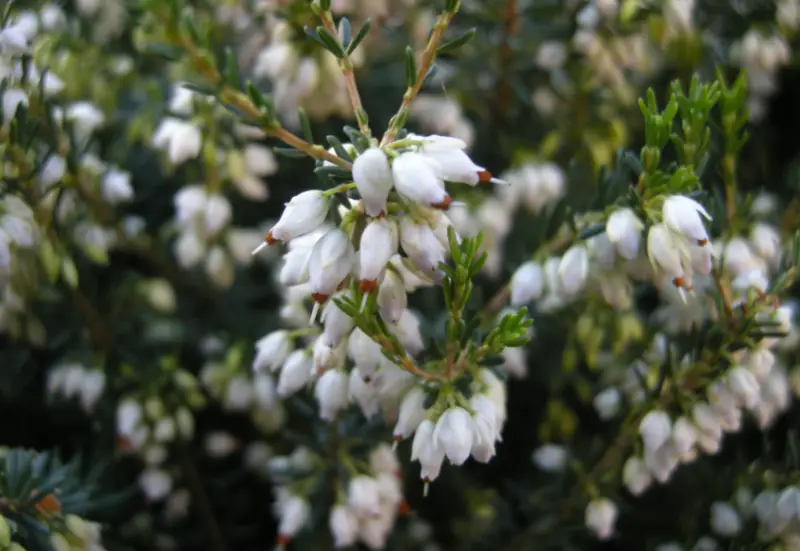
Winter Heath (Erica carnea) is a flowering evergreen subshrub in the Ericaceae family, native to mountainous regions of eastern, central, and southern Europe. It thrives on stony slopes and in coniferous woodlands.
This plant features spiny evergreen needles and produces rows of beautiful, pendulous, bell-shaped flowers that bloom in winter to early spring, with colors ranging from white to deep pink. Known for its hardiness, it is also referred to as alpine heath, spring heath, or winter-flowering heather.
Dianthus Flowers
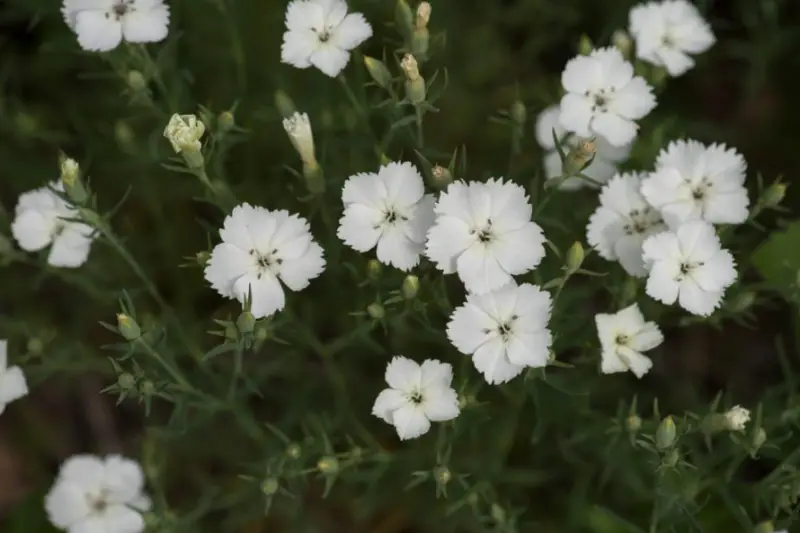
Dianthus (Dianthus) is a genus in the Caryophyllaceae family, containing around 340 species, mostly native to Asia and Europe, with a few from Africa and one from Arctic North America. Popular species include Dianthus plumarius (pinks) and Dianthus caryophyllus (carnations).
Known for their charming, slightly ruffled or zigzagged petal edges, these flowers often bloom in a variety of colors, including white. The genus name means “Zeus flower,” while the name “pink” likely refers to the petal edges’ distinctive perforated appearance.
Tulip Flowers
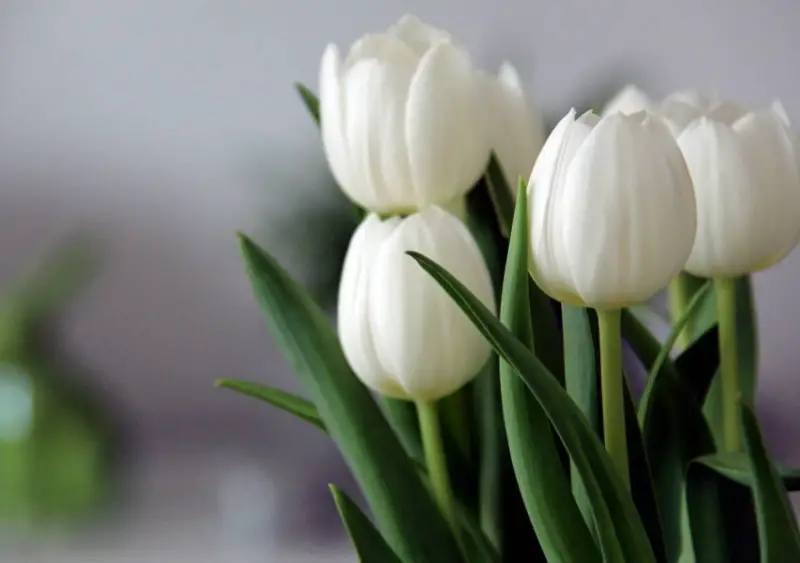
Tulips (Tulipa) are a genus of about 75 bulbous flowering plants in the Liliaceae family, native to western and central Asia. Although tulips have been cultivated globally for centuries, they originally spread along ancient trade routes.
These elegant flowers are available in thousands of cultivars and hybrids today. Among the popular white tulip varieties are Tulipa clusiana, Tulipa bifloriformis, Tulipa tukestanica, and Tulipa buhseana. White tulips, with their simple yet graceful form, are often found blooming in fields and gardens worldwide.
Japanese Wisteria
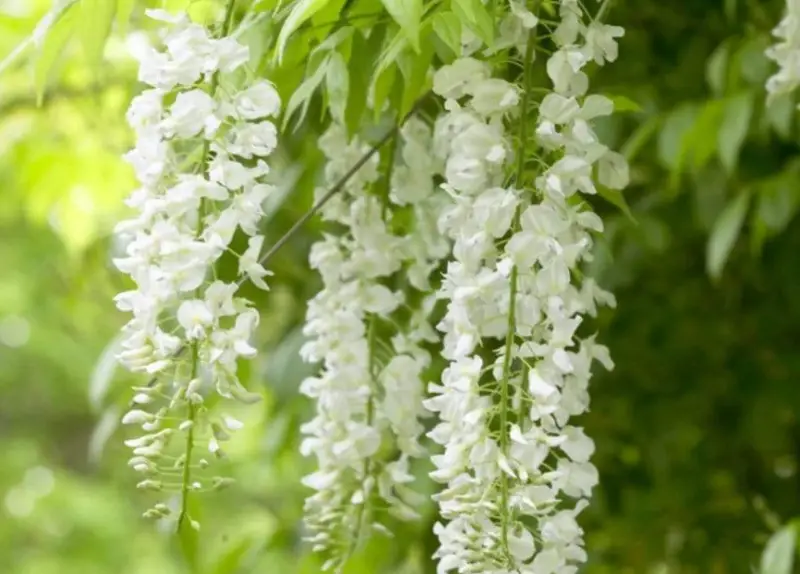
Japanese Wisteria (Wisteria floribunda ‘Alba’) is a beautiful white-flowering variety of wisteria, part of the Fabaceae family. This woody, climbing vine can wind up trees and structures, producing long, pendulous racemes of delicate white flowers, often reaching two feet in length.
Native to Japan, this wisteria creates a stunning display, especially when set against a bright blue sky. The white variety, ‘Alba,’ is famously showcased in Claude Monet’s garden at Giverny, particularly on the Japanese Bridge, adding to its magical charm.
White Rose Flowers
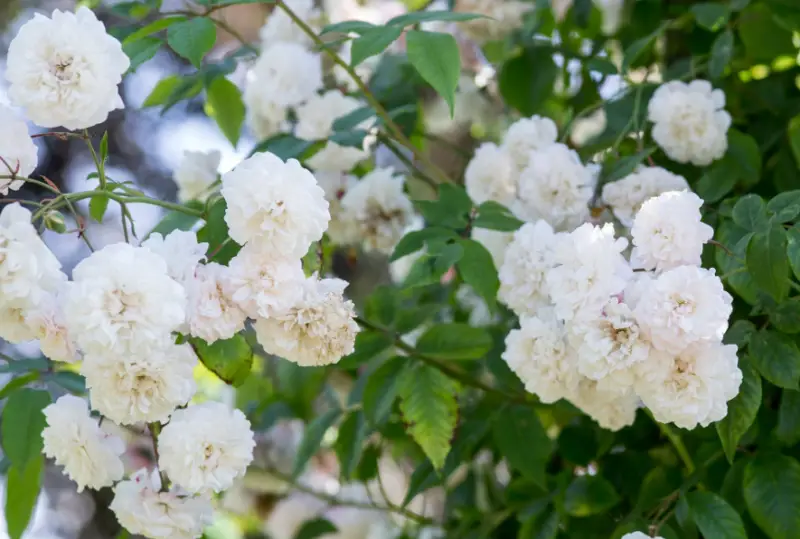
White Roses (Rosa) are part of the extensive Rosa genus, which includes over three hundred species of perennial flowering plants, along with tens of thousands of cultivars, all belonging to the Rosaceae family. While most rose species are native to Asia, several also thrive in North America, Europe, and Africa. This diversity offers a wide array of plants and flowers, making roses a beloved choice in gardens.
Popular white rose varieties include Vendela, Wollerton Old Hall, and Desdemona. A single white rose in bloom can create a striking image, especially when illuminated by sunlight breaking through tree cover.
Lobelia
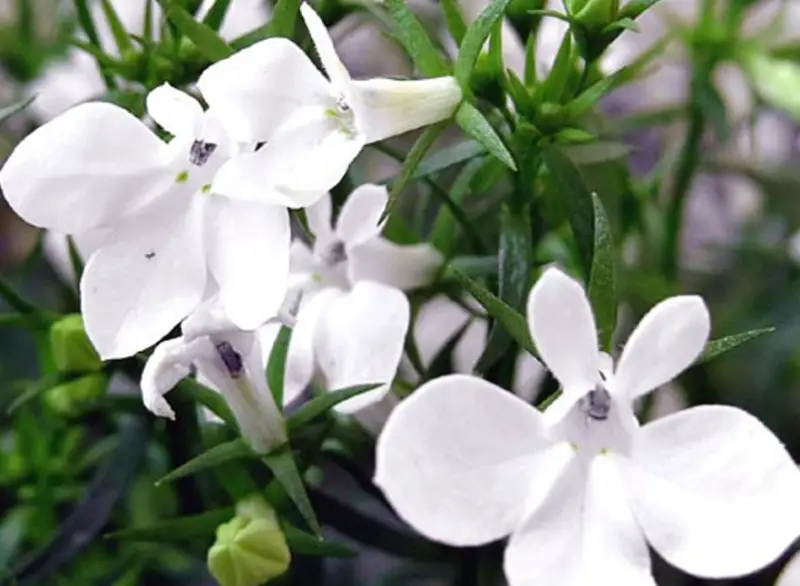
Lobelia (Lobelia) is a diverse genus comprising 415 species of annual and perennial flowering plants, both large and small, in the Campanulaceae family. Native to temperate, subtropical, and tropical regions around the world, lobelia plants are known for their charming appearance.
When in bloom, they display sweetly lobed, bottom-heavy blossoms in gentle shades of blue, pink, and snowy white, creating a beautiful visual impact. Commonly used as ornamental garden plants, lobelias are excellent choices for borders, flower beds, and large containers.
Japanese Andromeda
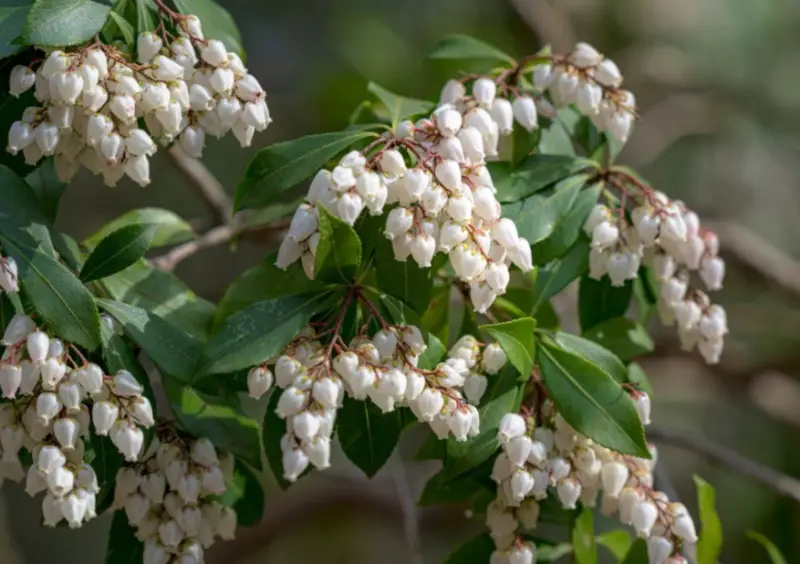
Japanese Andromeda (Pieris japonica) is a flowering plant in the Ericaceae family, native to the mountainous regions of eastern Asia. This species can grow up to 13 feet tall and features simple foliage that starts off in striking red or bronze hues before transitioning to a rich green.
One of its most notable characteristics is the stunning display of hanging clusters of urn-shaped flowers, which resemble outstretched fingers and bloom in soft shades of white, cream, and pink. These elegant flowers add beauty and texture to gardens and landscapes.
Lupine
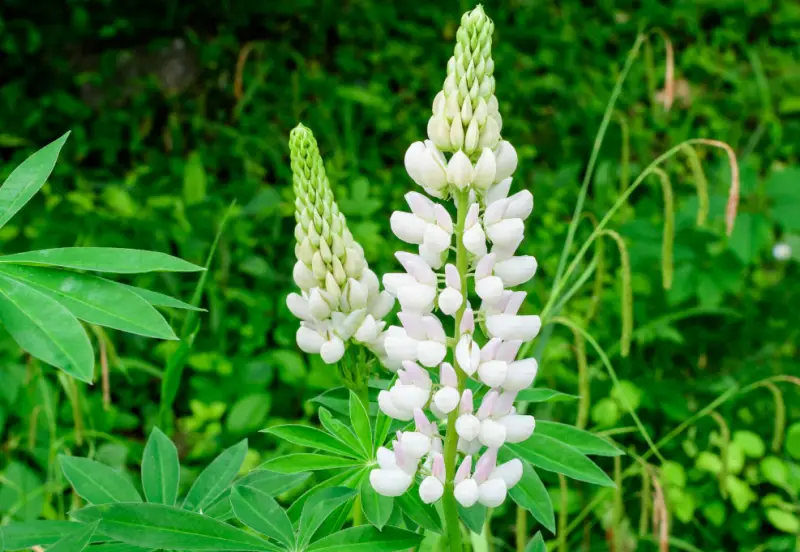
Lupine (Lupinus) is a genus in the Fabaceae family, comprising 199 species of herbaceous, primarily perennial flowering plants, mostly native to North and South America, with some species found in the Mediterranean and North Africa. These striking flowers feature tall, ornate racemes that bloom in various shades, including white, blue, purple, and pink.
While lupines are primarily cultivated as ornamental plants in gardens today, their seeds, which are legumes, have been enjoyed as food for thousands of years across different regions of the world.
Clematis Flowers
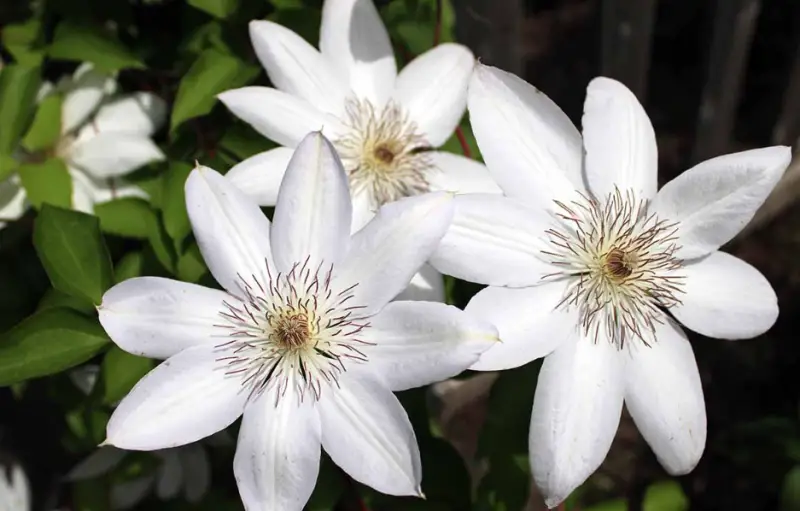
Clematis (Clematis) is a diverse genus containing roughly 300 species of flowering plants in the Ranunculaceae family. Most clematis plants are woody vines with climbing habits, though some species grow as herbaceous perennials and others as small shrubs. While one species is native to Britain, the majority are found in Japan and China.
With a wide range of species, hybrids, and cultivars, clematis flowers showcase an impressive variety of appearances and colors. However, they all share stunning symmetry and a captivating presence, making them a beloved choice in gardens.
Pincushions
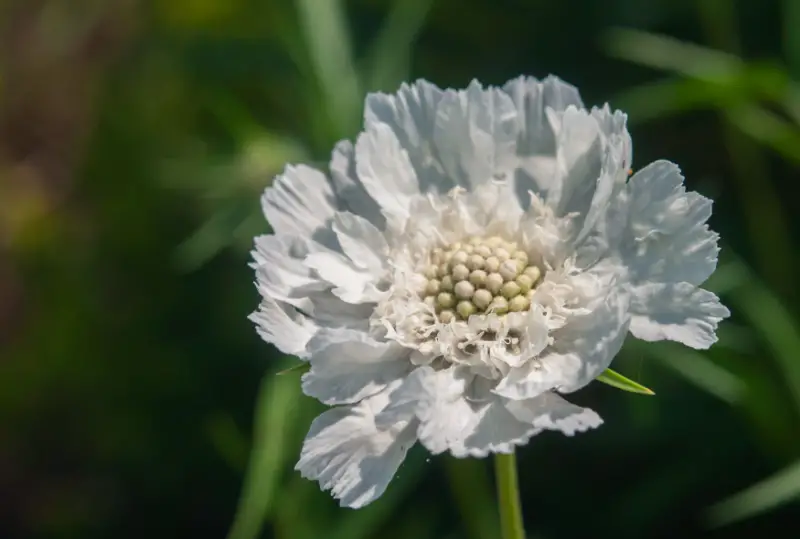
Pincushions (Scabiosa) belong to the Caprifoliaceae family and comprise a genus of flowers native to Asia, Europe, and Africa. While some species are referred to as “scabious,” most are commonly known as pincushion flowers due to their distinctive appearance.
The flowers feature ruffled petals that encircle a central globe of spiky bracts and calyces, resembling a pincushion. A single pure white pincushion flower stands out beautifully against a backdrop of lush green foliage, making it a striking addition to gardens and floral arrangements.
Easter Lily
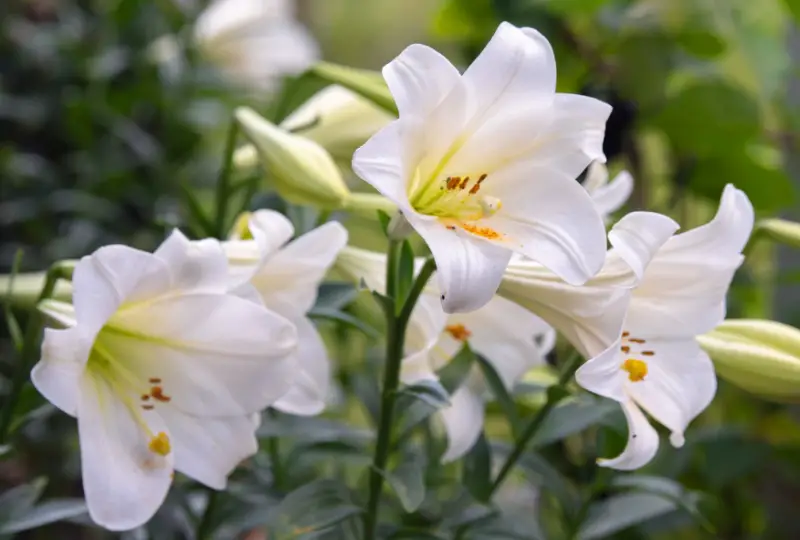
Easter Lily (Lilium longiflorum) is a flowering plant species in the Liliaceae family, known for its stunning trumpet-like white blooms. These lily plants can grow between 20 inches and three feet tall, featuring deep-green stalks adorned with long, ovate leaves that extend from the base to the top. At the top of the stalk, clusters of pure-white, star-shaped flowers emerge, creating a striking display.
In Christianity, Easter lilies hold significant symbolism, representing the resurrection of Christ, and are often used to decorate churches and altars during the Paschal season.
Begonia Flowers
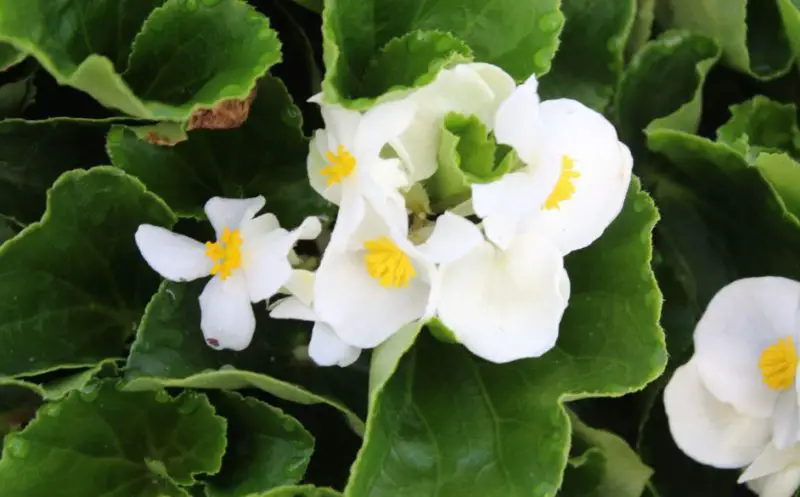
Begonia (Begonia) is a diverse genus within the Begoniaceae family, comprising 2,002 accepted species native to tropical and subtropical regions of Africa, Asia, and the Americas, making it the largest genus of flowering plants.
Begonia flowers are known for their remarkable variety, featuring foliage that ranges from dark green to burgundy, and blossoms in shades of pink, yellow, orange, and red. The white begonia flowers are particularly striking, with soft, buttery petals that can vary from snowy white to a warm, milky cream color, adding elegance to any garden or indoor space.
Butterfly Bush
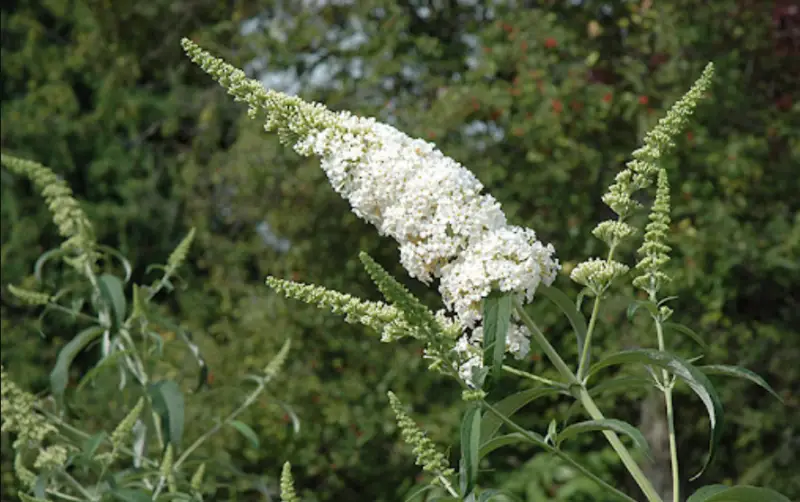
Butterfly Bush (Buddleja) is a genus in the Scrophulariaceae family, comprising over 140 primarily flowering shrubs, with a few species classified as small trees. Native to the Americas, Africa, and Asia, these plants are renowned for attracting butterflies and other pollinators.
The white butterfly bush showcases striking plumes of small white flowers that bloom in pointed cones, resembling fireworks bursting from the central leafy shrubs. A butterfly often perches atop these blooms, enhancing the visual appeal and highlighting the plant’s role as a vital part of the garden ecosystem.
Snows of Kilimanjaro
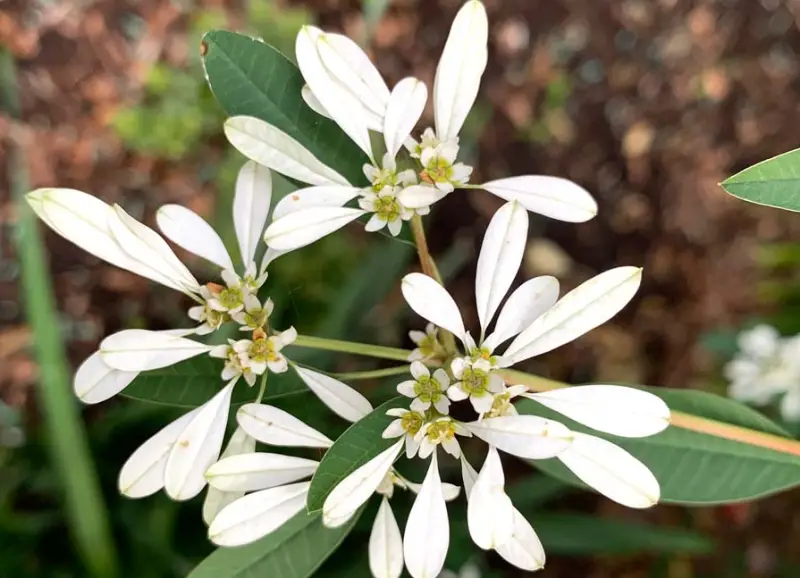
Snows of Kilimanjaro (Euphorbia leucocephala) is a flowering shrub or small tree belonging to the Euphorbiaceae family, native to Mexico and parts of Central America. Commonly referred to as white lace euphorbia, snow bush, Christmas flower, and snowflake bush, this plant is renowned for its stunning display during blooming.
When in full bloom, corymbs of delicate, pure white flower petals envelop the tree, creating the enchanting illusion that it is covered in freshly fallen snow. This striking visual effect makes it a popular choice for gardens and landscapes.
Azalea Flowers
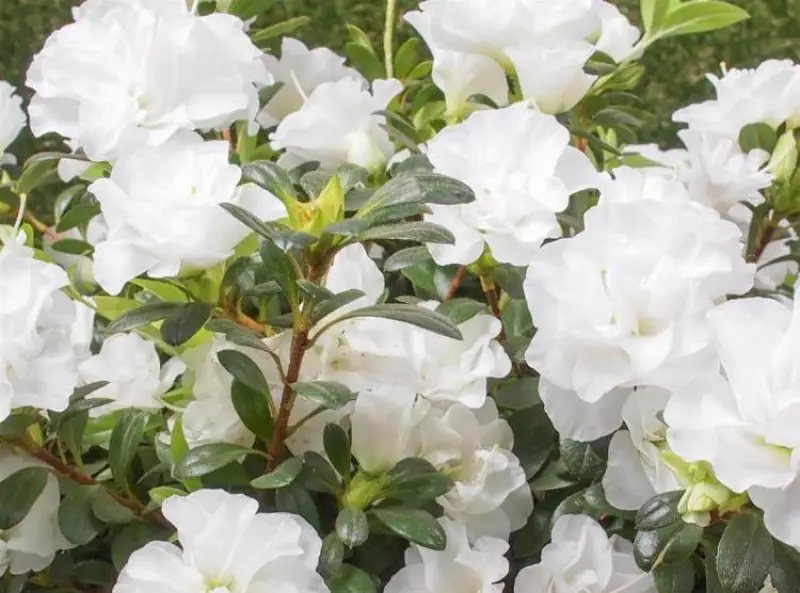
Azalea Flowers (Rhododendron) are vibrant flowering shrubs native to North America, Europe, and Asia, belonging to the Rhododendron genus in the Ericaceae family. These plants can be either evergreen or deciduous, typically blooming in the spring with large clusters of fluttery blossoms in shades of red, pink, and white.
The striking beauty of azalea flowers has led many cities in the United States, Japan, Korea, and Hong Kong to celebrate azalea festivals during their blooming seasons, showcasing the splendor of these beloved plants in full bloom.
Snowdrop
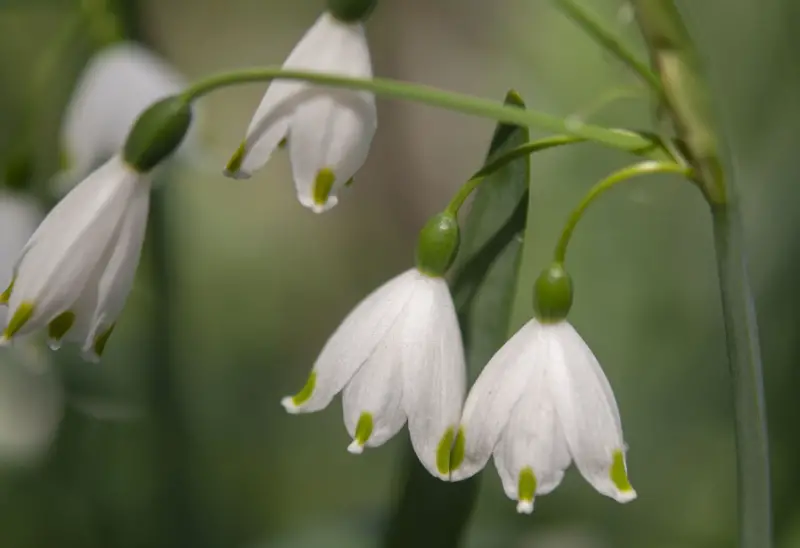
Snowdrop (Galanthus) is a genus of about 20 species of bulbous, herbaceous perennials in the Amaryllidaceae family, native to Europe and the Middle East. Commonly called snowdrops, these delicate flowers bloom in early winter, late fall, or early spring, signaling the arrival of a new season.
Their snowy-white, bell-like flower heads often have a small yellow or green marking at the tip. Although their flowers hang pendulously, when lifted, their intricate and unique beauty is revealed.
Candytuft
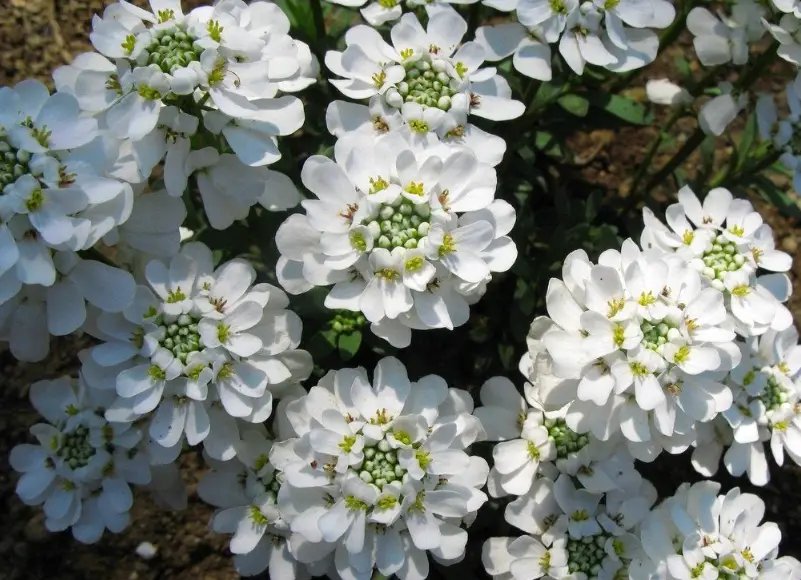
Candytuft (Iberis) is a genus comprising about 30 species of woody, flowering, annual and perennial evergreen subshrubs, belonging to the Brassicaceae (mustard) family. Native to various regions of the Old World, the common name “candytuft” is derived from Candia, the former name of the Island of Crete, now known as Iraklion.
These low-growing white flowers bloom profusely in garden beds, creating a stunning display of blossoms when in full bloom. One particularly charming variety is the snowflake candytuft (Iberis sempervirens), which adds delightful charm and color to your garden.
Lilac Flowers
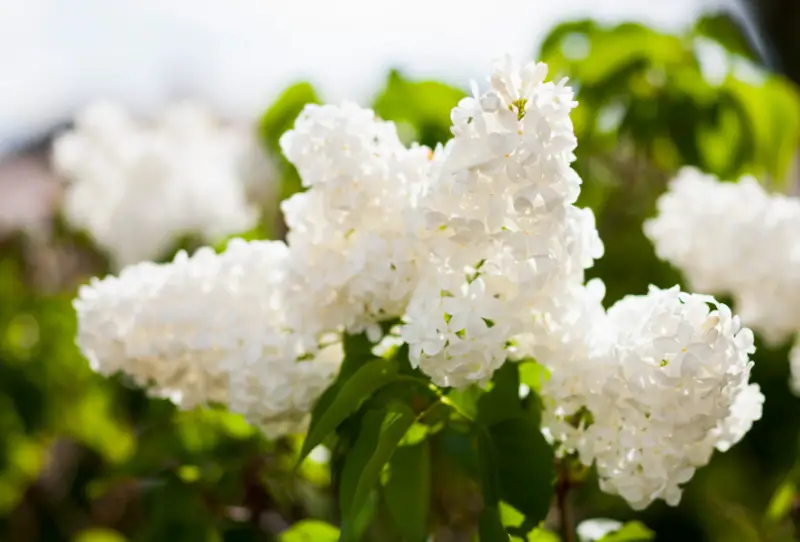
Lilac Flowers (Syringa) consist of twelve flowering plants within the Oleaceae (olive) family, including woody shrubs and small trees native to Europe and Asia. These lovely plants boast deciduous foliage and produce large, cone-shaped clusters of blossoms, which, despite being relatively short-lived, are cherished for their unmistakably sweet, classic fragrance.
A cluster of soft white lilac flowers, often featuring yellow centers, creates a stunning display in gardens. In addition to white, lilacs also bloom in soft shades of pink, lavender, and blue, making them a popular choice for gardeners seeking vibrant colors and delightful scents.
Creeping Dogwood
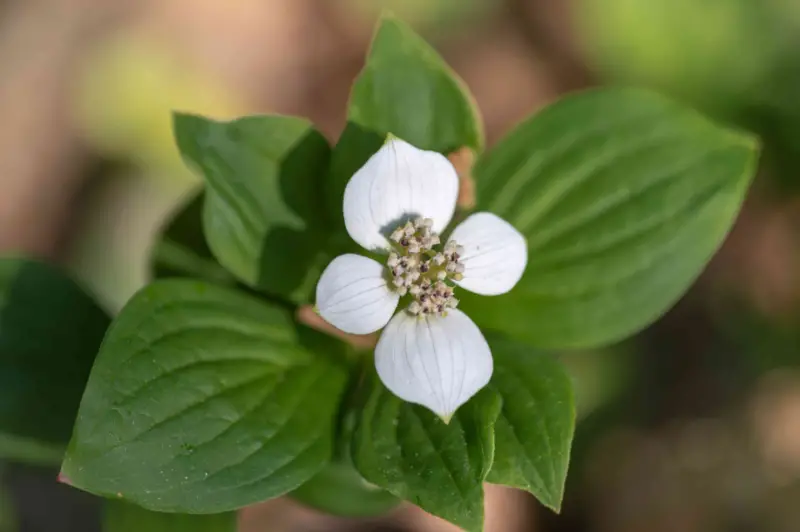
Creeping Dogwood (Cornus canadensis) is a member of the Cornaceae (dogwood) family, native to both North America and eastern Asia. This flowering plant features a slow, creeping growth habit, with rhizomes producing short, star-shaped rosettes of spade-shaped leaves that typically reach four to eight inches in height. From these leaves, solitary, four-petaled white flowers emerge, showcasing tiny flower heads against a backdrop of large green leaves.
These charming seasonal flowers serve as an attractive ground cover for areas in your garden where foot traffic is minimal. Commonly known as Canadian bunchberry, quatre-temps, Canadian dwarf cornel, and crackerberry.
Ranunculus Flowers
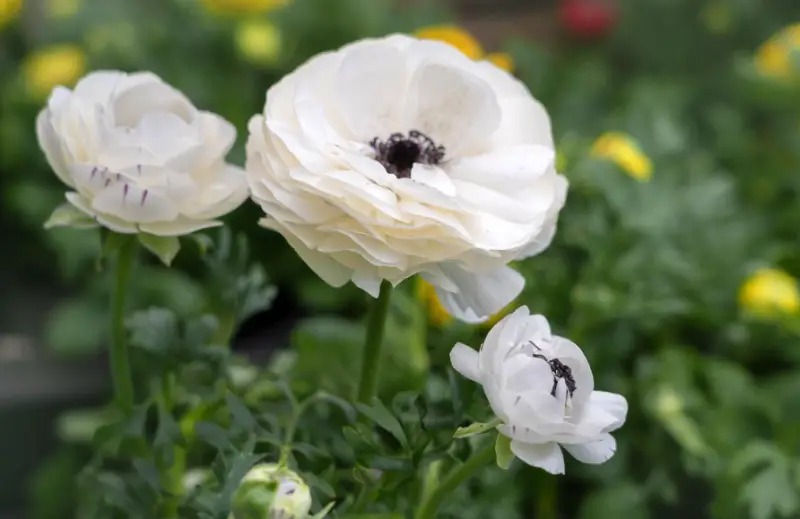
Ranunculus Flowers (Ranunculus) belong to the Ranunculaceae (buttercup) family, encompassing around 600 species of mostly perennial, herbaceous flowering plants. This diverse genus includes both aquatic and terrestrial flowers, commonly known as crowfoots, buttercups, and spearworts, alongside the popular ranunculus blossoms favored by florists.
Characterized by fingered leaves that typically form a rosette near the base of the stem, ranunculus flowers, particularly those from cultivated hybrids of the Ranunculus asiaticus species, are renowned for their ornate appearance. The flowers feature tightly spiraled whorls of paper-like white petals, creating stunning arrangements, especially when displayed in a vase.
Passionflower
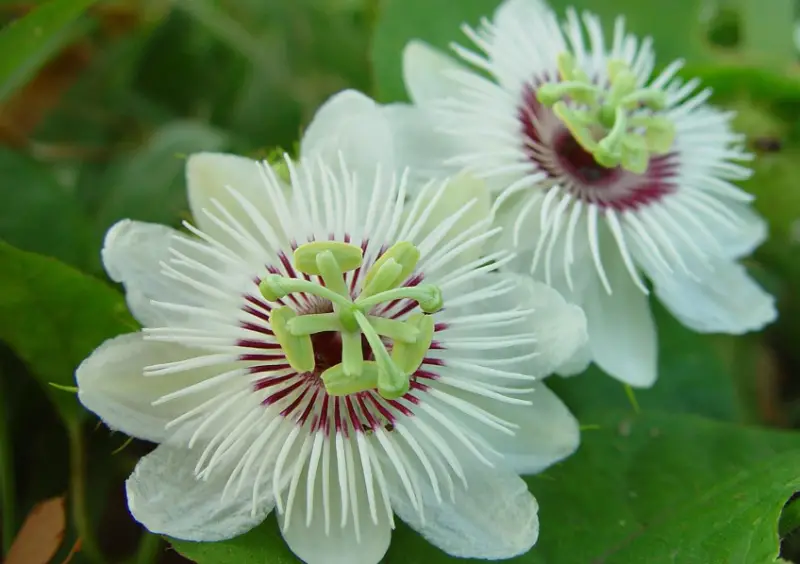
Passionflower (Passiflora foetida) is an exotic species belonging to the Passifloraceae family, native to regions including South America, Central America, Mexico, the southwestern United States, and the Caribbean. It features striking white blooms that showcase distinct layers of ray florets and petioles surrounding purplish centers, creating an alluring appearance against tropical green leaves.
Despite their beauty, the leaves emit a pungent odor when disturbed, earning the plant its nickname, “stinking passionflower.”
Queen Anne’s Lace
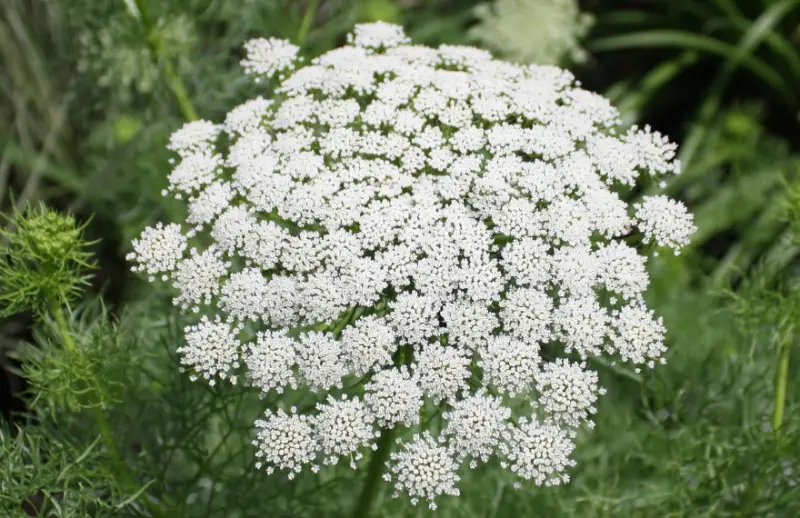
Queen Anne’s Lace (Daucus carota) is a member of the Apiaceae (carrot) family, native to the temperate regions of the Old World. Commonly known as wild carrot, bishop’s lace, and bird’s nest, this herbaceous flowering plant is celebrated for its intricate beauty.
The leaves are finely detailed, resembling embroidery, while the large corymbs display tiny, delicate white flowers that evoke the appearance of lace.
Camellia Flowers
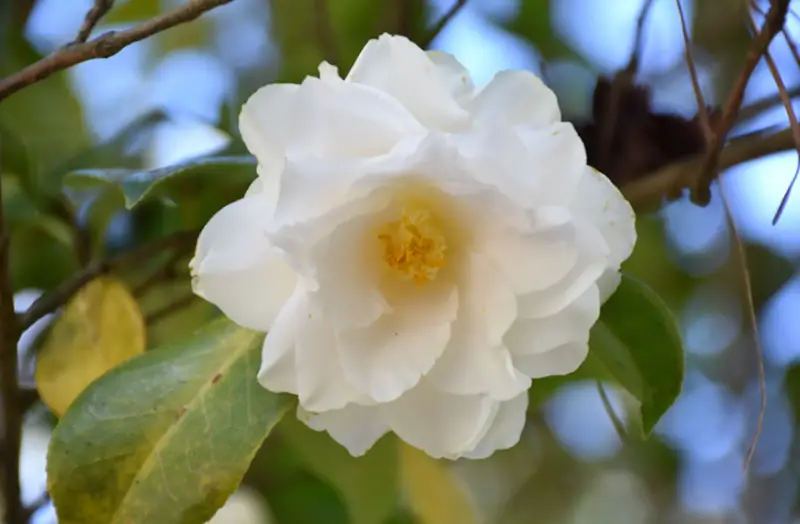
Camellia Flowers (Camellia) belong to the Theaceae (tea) plant family and encompass a genus of small, flowering, evergreen trees and shrubs. The number of accepted species ranges from 100 to 300, along with approximately 3,000 hybrids.
These plants are celebrated for their stunning blooms in shades of white, pink, and red. Native to eastern and southern Asia, camellias are cultivated not only for their beautiful flowers but also for their leaves, which are used to make tea.
Tuberose
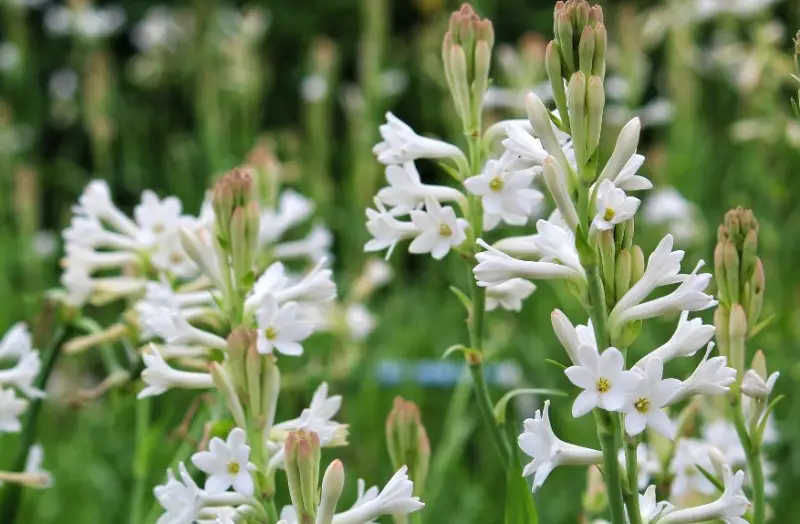
Tuberose (Agave amica) is an herbaceous, flowering perennial plant native to Mexico, belonging to the Asparagaceae (asparagus) family. This plant grows from a tuberous root system, producing tall, slender stalks that bear cone-shaped racemes of trumpet-shaped flowers.
Tuberose flowers are not only beautiful additions to gardens but are also highly valued for their strong-smelling essential oils, which are commonly used to enhance floral notes in perfumes and fragrances.
Phlox Flowers
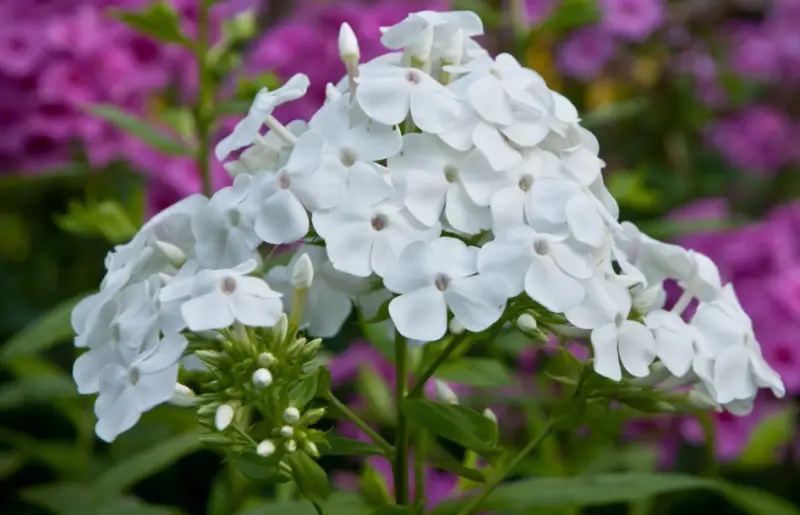
Phlox is a diverse genus of 67 species of annual and perennial plants that belong to the Polemoniaceae plant family. Most species are native to North America, with the exception of one species from Siberia. Phlox plants exhibit a variety of growth habits, including upright, creeping, and mat-like forms.
They are characterized by vibrant green foliage and clusters of small white flowers, making them popular choices for garden displays. Their beauty and resilience add charm to various landscapes.
Sweet Alyssum
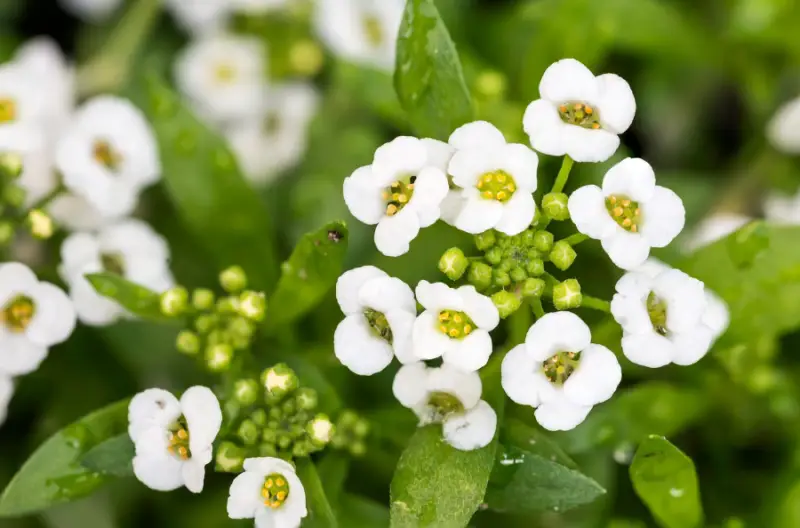
Sweet Alyssum (Lobularia maritima) is a charming annual flowering plant belonging to the Brassicaceae (mustard) family, native to Micronesia and the Mediterranean regions. Characterized by its low-growing habit, it features long, narrow, and heavily branched stems that bear clusters of tiny white flowers adorned with yellow centers at the tips.
This delightful plant is often used as ground cover, around the edges of raised garden beds, and in hanging baskets, thanks to its attractive trailing growth habit.
Water Lily
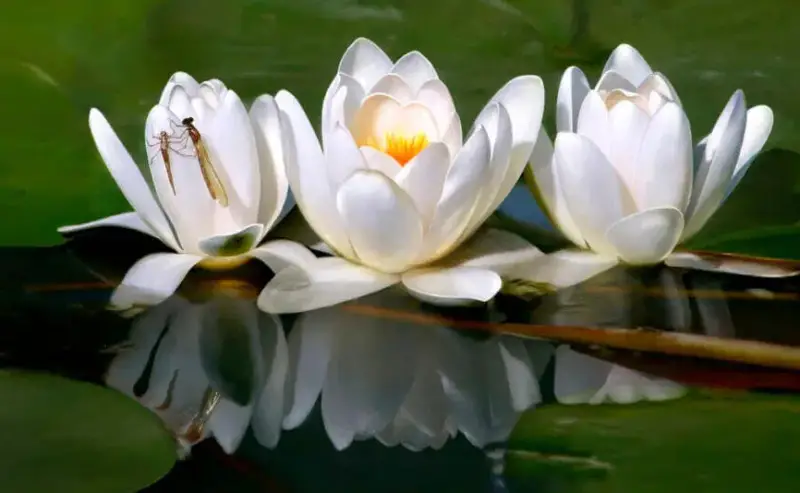
Water Lily (Nymphaeaceae) showcases a single white flower in bloom, featuring bright yellow stamens in the center. This family of aquatic flowering plants consists of five separate genera and around 70 species commonly known as water lilies, which thrive in tropical, subtropical, and temperate climates worldwide. The plants anchor their roots in the soil beneath water bodies while their floating foliage, known as lily pads, gracefully extends above.
The cup or bowl-shaped flowers have symmetrical arrangements of pointed petals, blooming in various shades, including white, pink, red, purple, blue, orange, and yellow.
Christmas Rose
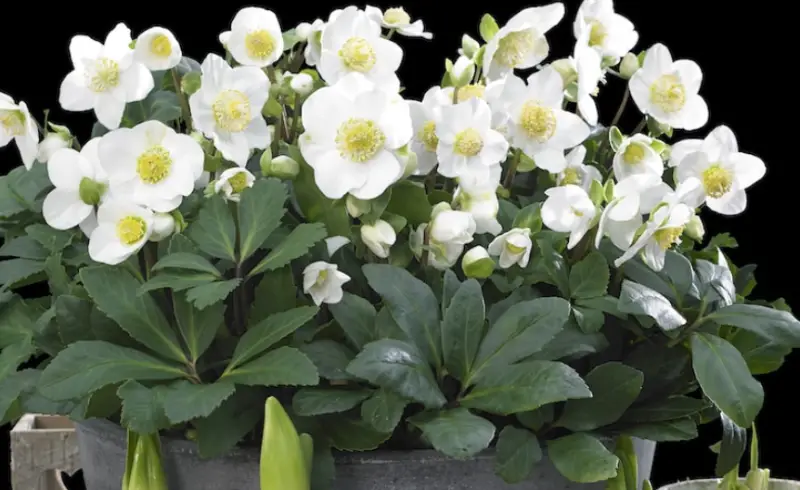
Christmas Rose (Helleborus niger) features a small cluster of white blooming flowers. Native to the mountainous regions of Europe, this evergreen perennial belongs to the Ranunculaceae plant family. While the plant is quite poisonous, it produces stunning, star-shaped flowers with snowy-white petals and bright yellow centers.
Known as the Christmas rose, this species is also sometimes referred to as the black hellebore, highlighting the distinctive black-colored roots of the plant.
Columbine Flowers
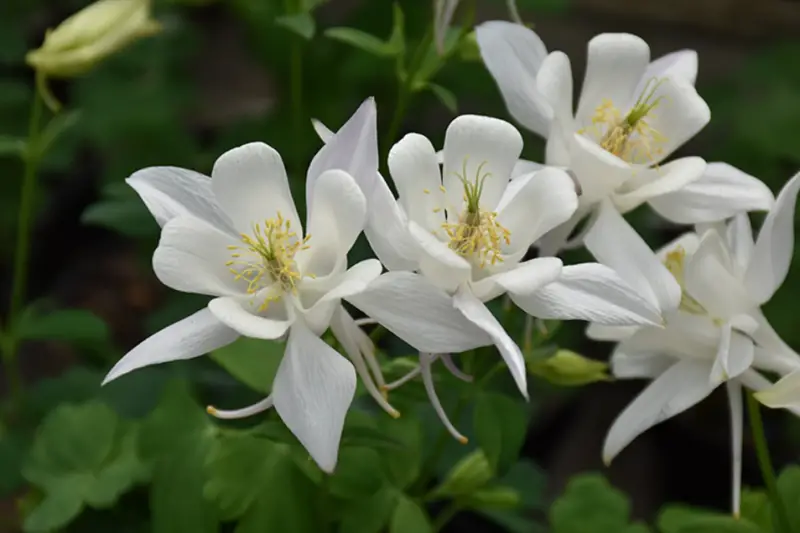
Columbine Flowers (Aquilegia) showcase white blooms growing in a rocky location. Native to high altitudes across the Northern Hemisphere, Aquilegia is a genus comprising about 60 to 70 species of herbaceous, perennial plants.
These flowers are known for their distinctive spurred petals, and many hybrids and cultivars have been developed to display ornate, multicolored inflorescences. The Colorado blue columbine, featuring striking blue and white petals, is the state flower of Colorado, highlighting the beauty of this diverse genus.
Yarrow Flowers
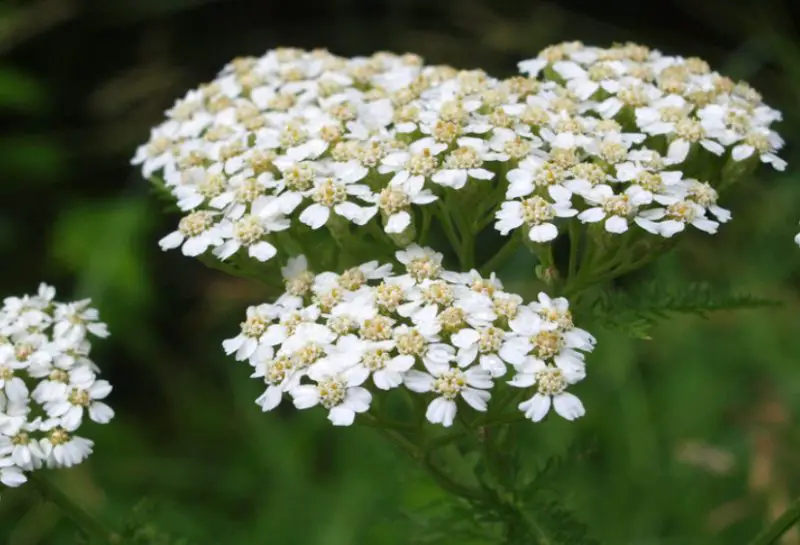
Yarrow Flowers (Achillea millefolium) showcase flat-topped clusters of petite, white blooms, each with a distinctive flat disc shape. Native to the temperate regions of the Northern Hemisphere, this herbaceous perennial belongs to the Asteraceae plant family.
The flowers can range from white to pink, attracting various wildlife. They offer ecological benefits, providing nesting material for birds and nourishment for insects, making them a valuable addition to gardens and natural landscapes.
False Goat’s Beard
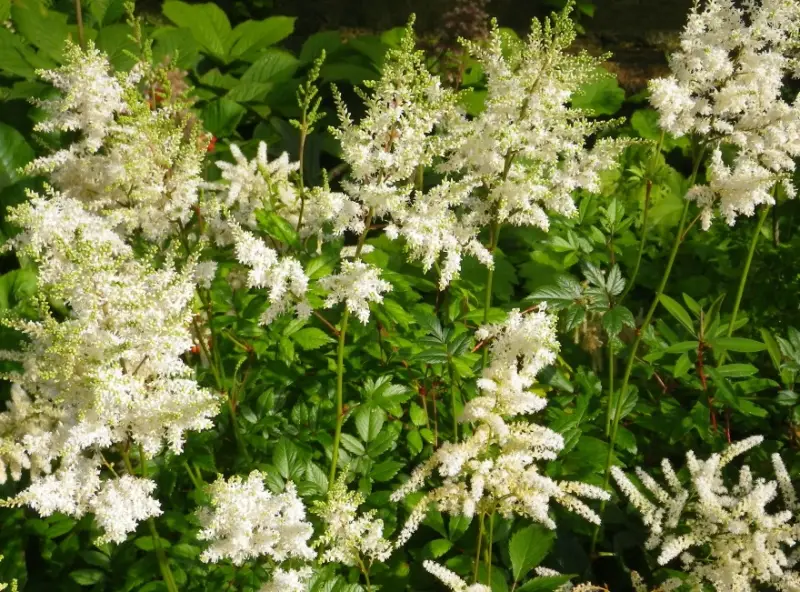
False Goat’s Beard (Astilbe) showcases clumps of dense, green foliage alongside prominent, flame-like spikes of feathery white flowers. As a member of the Saxifragaceae plant family, this genus includes 18 flowering plants native to North America and Asia, commonly known as false spirea or false goat’s beard.
Astilbe blossoms in a variety of colors, including red, pink, lavender, white, and cream. Preferring water-logged conditions, these plants are ideal for planting near ponds or in clay or poorly draining soil.
Primrose Flowers
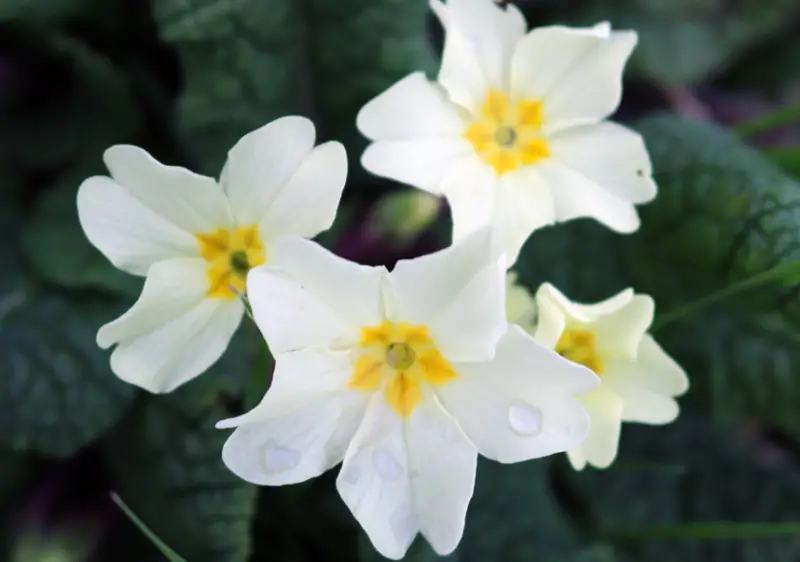
White Primrose Flowers (Primula vulgaris) bloom gracefully against a backdrop of deep green leaves and foliage. This species, native to Europe, Africa, and Asia, belongs to the Primulaceae (primrose) plant family. Commonly referred to as primrose or English primrose, it features a rosette of foliage from which several flowers emerge in early spring.
While the typical blooms are white and yellow, pink varieties also exist, and the Japanese primrose is available in stunning white flowers.
Lily of the Valley
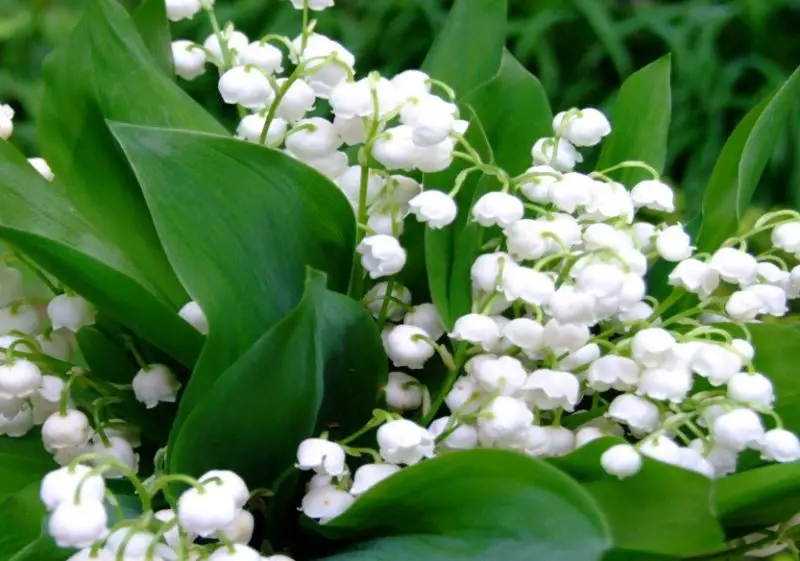
Lily of the Valley (Convallaria majalis) displays delicate stems from which sprays of plump, bell-shaped white flowers bloom gracefully. This flowering plant belongs to the Asparagaceae (asparagus) family and is commonly known as lily of the valley.
Native to much of the temperate regions of the Northern Hemisphere in Asia and Europe, it is considered an invasive species in North America, unlike the native variety Convallaria majalis var. montana. The sweet-scented blooms are often used in perfumes.
Stephanotis
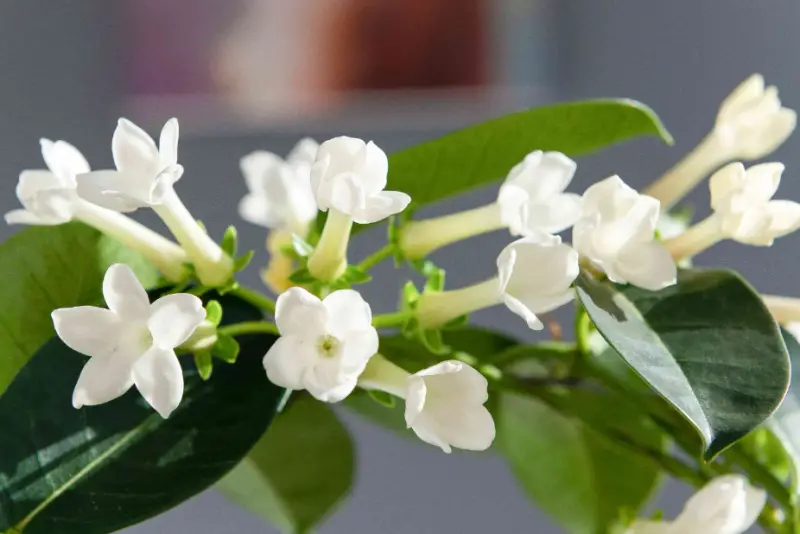
Stephanotis (Stephanotis) vines are in bloom, showcasing bright white tubular flowers that stand out against their lush, green foliage. The Stephanotis genus comprises nine woody flowering vines within the Apocynaceae (dogbane) plant family.
These plants have a diverse native distribution, with species found in Madagascar, Japan, Cuba, Malaysia, and Borneo. Often cultivated in tropical gardens or greenhouses, they are prized for their attractive, waxy leaves and intensely fragrant blooms.
Water Hyssop
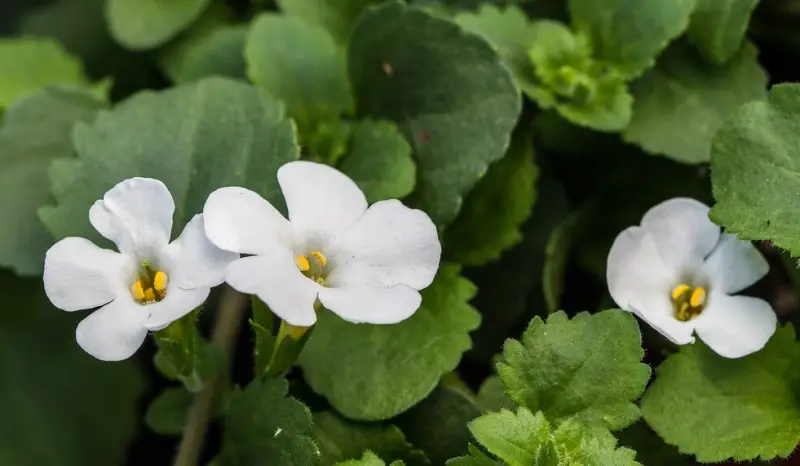
Water Hyssop (Bacopa monnieri) showcases long, oblong, succulent leaves paired with small white flowers that create a charming display. A member of the Plantaginaceae (plantain) family, this perennial, creeping herb grows natively on every continent except Antarctica.
Though its appearance is slightly unusual, it has been widely recognized in Ayurvedic medicine for its potential benefits in improving memory and treating various ailments. However, it’s important to note that it has side effects and has not received FDA approval for medical use.
Angelonia
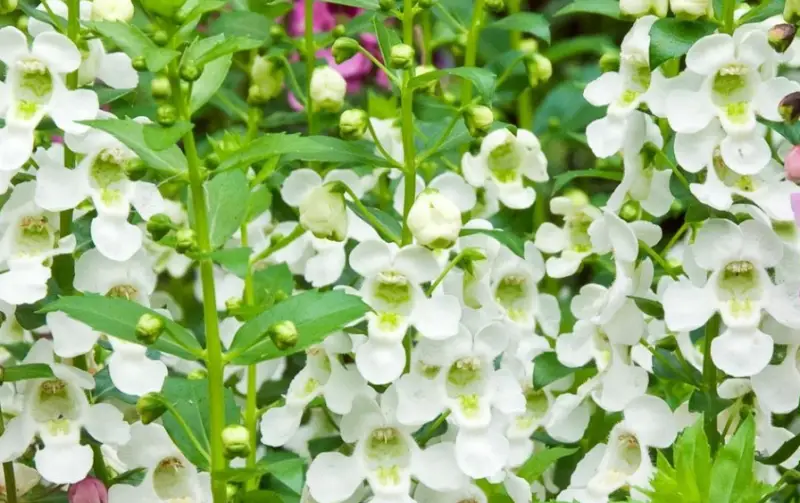
Angelonia (Angelonia) showcases tall racemes of snapdragon-like white flowers against pointed, lance-like leaves. This genus, which includes about 30 herbaceous flowering plants, belongs to the Plantaginaceae family and is predominantly native to northeastern Brazil, thriving in the Caatinga Forest, a semi-arid habitat.
These charming plants bloom in various colors, with white being a popular choice for ornamental varieties. They flourish in warm temperatures and require ample direct sunlight, making them perfect for sunny garden spots away from shade.
Periwinkle Flowers
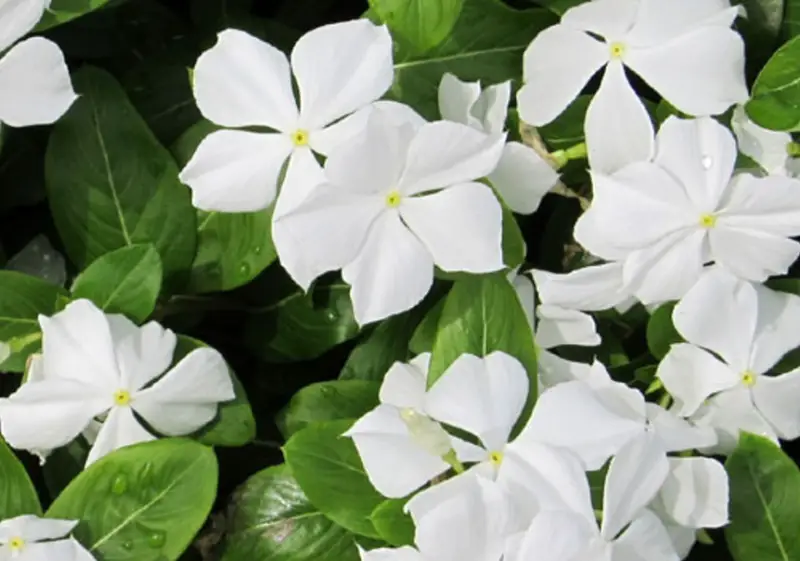
Periwinkle Flowers (Vinca) showcase a close shot of white blooms against glossy foliage. A member of the Apocynaceae (dogbane) plant family, the Vinca genus consists of seven species of subshrubs and herbaceous plants, known for their salverform flowers.
While most commonly blue, white variations are also found. Native to the Mediterranean and North African regions, periwinkles have been introduced to many areas and are considered invasive species in the United States, Canada, New Zealand, and Australia.
Windflower
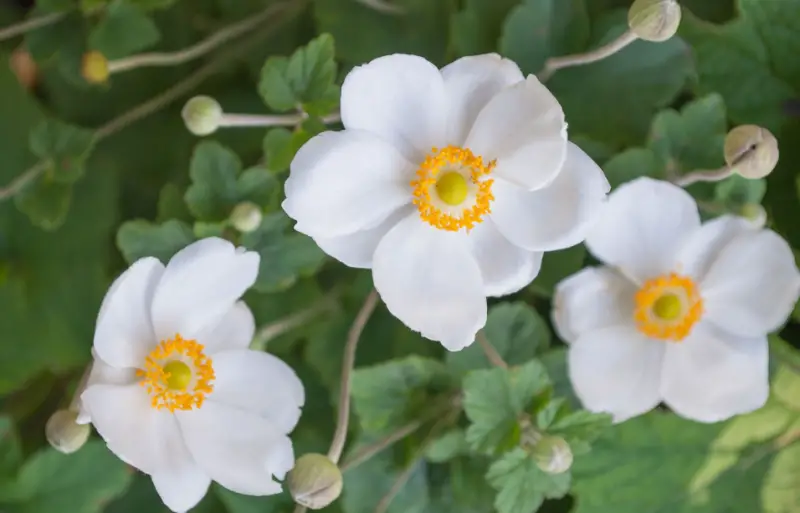
Windflower (Anemone) features a group of bright white blooms with yellow centers. Native to subtropical regions of North and South America, Africa, Europe, and Asia, the Anemone genus comprises about 120 flowering perennials belonging to the Ranunculaceae (buttercup) plant family.
The blossoms have a shape that resembles the classic flower doodle, characterized by a circular center surrounded by sepal-like bracts in white and various other vibrant colors, making them a charming addition to gardens.
Gardenia Flowers
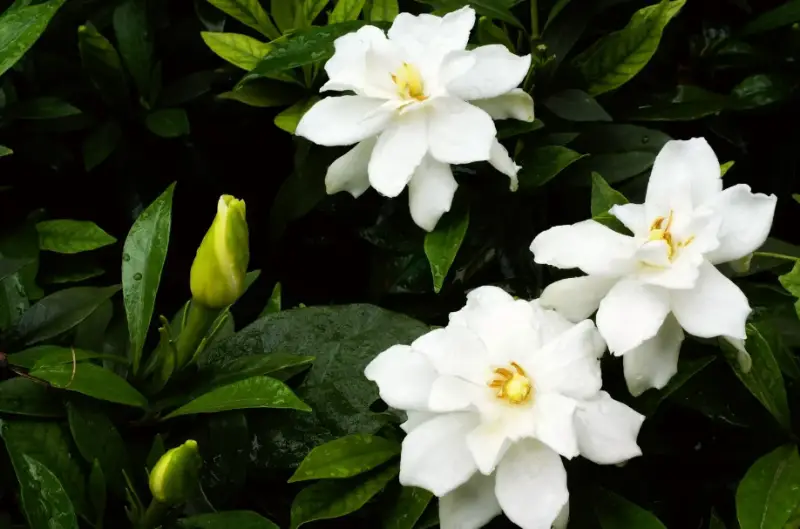
Gardenia (Gardenia) showcases a single creamy white flower in bloom against deep green leaves. The Gardenia genus comprises 140 accepted species of flowering evergreen shrubs and small trees within the Rubiaceae (coffee) plant family, native to tropical and subtropical regions of Australia, the Pacific Islands, Madagascar, Africa, and Asia.
While most flowers exhibit a classic whorl shape with snowy-white petals, some varieties bloom in yellow. Gardenias are cherished for their ornamental beauty and strong, pleasant floral scent, making them a popular choice in perfumes.
Dogwood
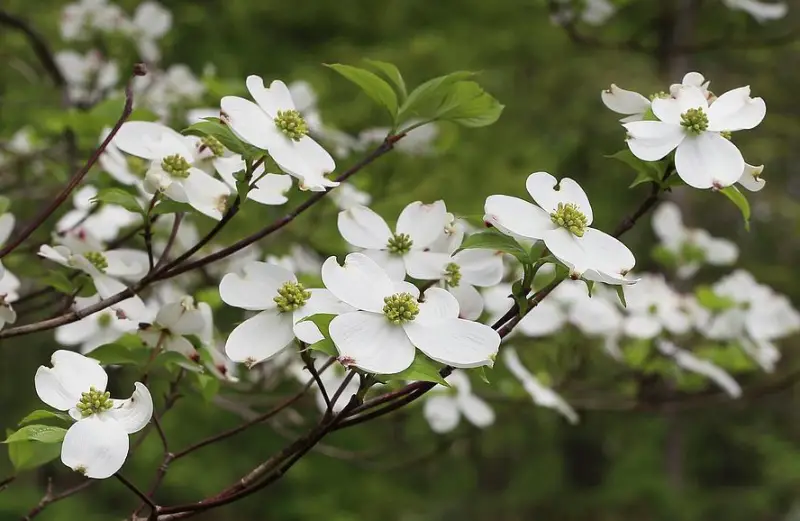
Dogwood (Cornus) features flowers in bloom with brilliantly white petals on a sunny day against an intensely blue sky. The Cornus genus, native to Europe, Asia, and North America, includes between 30 and 60 species that belong to the Cornaceae plant family.
Most species are woody deciduous trees, shrubs, or subshrubs, while a few are herbaceous perennials or evergreens. Their profusion of white blossoms during the blooming season makes them highly desirable as ornamental shrubs and trees in gardens.
Peace Lily
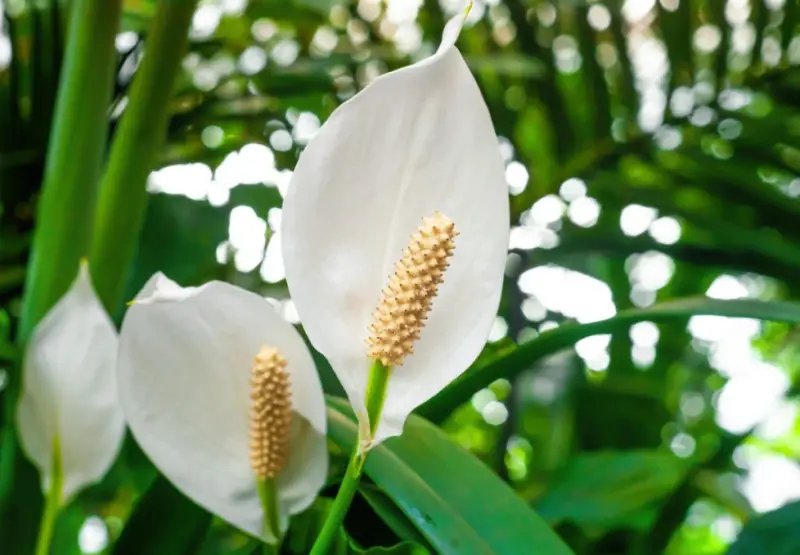
Peace Lily (Spathiphyllum) showcases a bright white spathe from the peace lily plant. A member of the Araceae (arum) plant family, the Spathiphyllum genus consists of 47 species of flowering, evergreen, herbaceous, perennial plants that are native to the tropical regions of southeastern Asia and the Americas.
Commonly referred to as peace lilies, these plants feature stunning, glossy green foliage with large leaves that radiate from the center in a thick burst. When in bloom, stems rise from the foliage, topped with spade-shaped white spathes that encircle finger-like spadices. Peace lilies symbolize purity, innocence, sympathy, and prosperity, and they also possess air-purifying qualities, making them excellent houseplants.
Jasmine Flowers
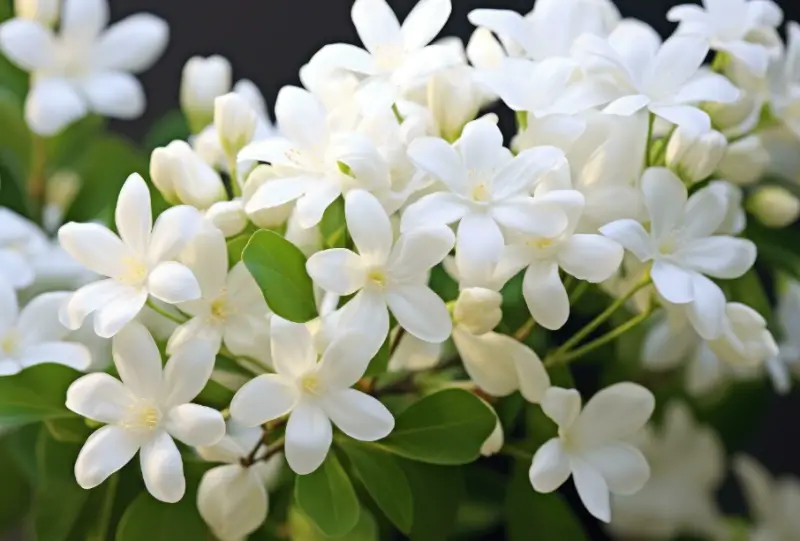
Jasmine Flowers (Jasminum) display white blooms clustered together. Native to the tropical and subtropical regions of Oceania, Australasia, Africa, Asia, and Europe, the Jasminum genus comprises about 200 flowering vines and shrubs within the Oleaceae plant family.
This genus includes both deciduous and evergreen plants, showcasing a variety of foliage types. Jasmine flowers, typically about an inch in diameter, are usually white or yellow and can have a slight reddish hue.
Despite their small size, they are known for their intense fragrance. Jasmine is cultivated not only for ornamental purposes but also for use in tea, perfumes, and various cultural traditions.
Heliotrope
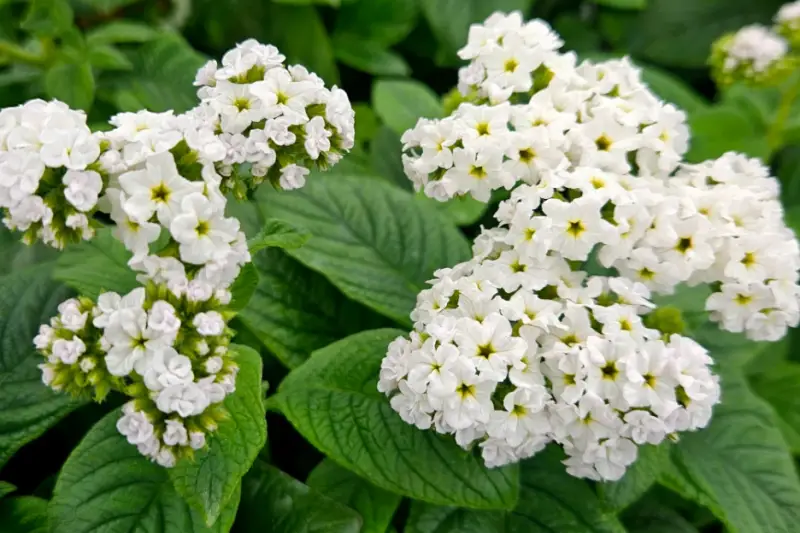
Heliotrope (Heliotropium arborescens ‘Albans’) showcases clusters of tiny white flower heads. Native to northern South America, this species is a flowering perennial plant belonging to the Boraginaceae (forget-me-not) family.
While the species typically features lavender or purple flowers, this cultivar has been specifically bred to produce snowy-white blossoms. Heliotropes grow in bushy, evergreen shrubs, and their small flowers are cherished for their sweet, vanilla-like fragrance.
False Shamrock
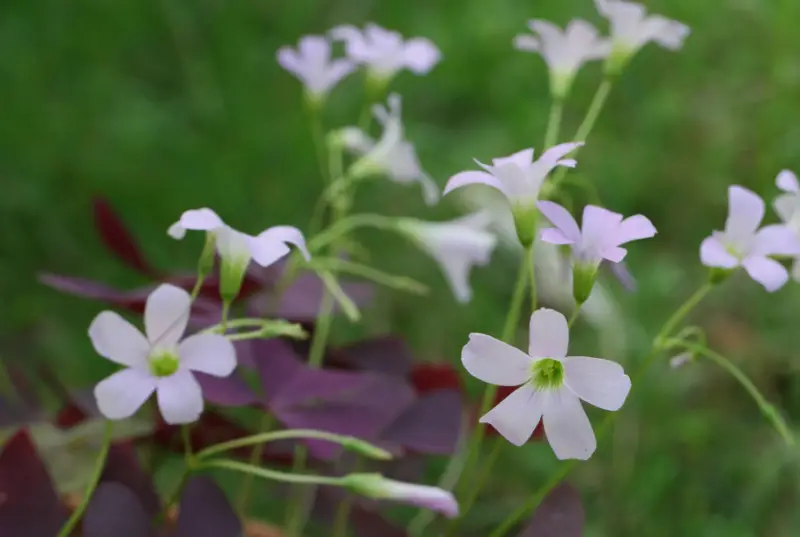
False Shamrock (Oxalis triangularis) features bright white flowers emerging from the plant. A member of the Oxalidaceae (wood sorrel) family, this perennial species is native to the southern regions of South America.
Commonly known as false shamrock, it has distinctive leaves that can be dark purple or green, with three leaflets often mistaken for true shamrock. The plant produces small, star-shaped white flowers with five petals and spreads easily through its tuberous rhizomatic root systems.






